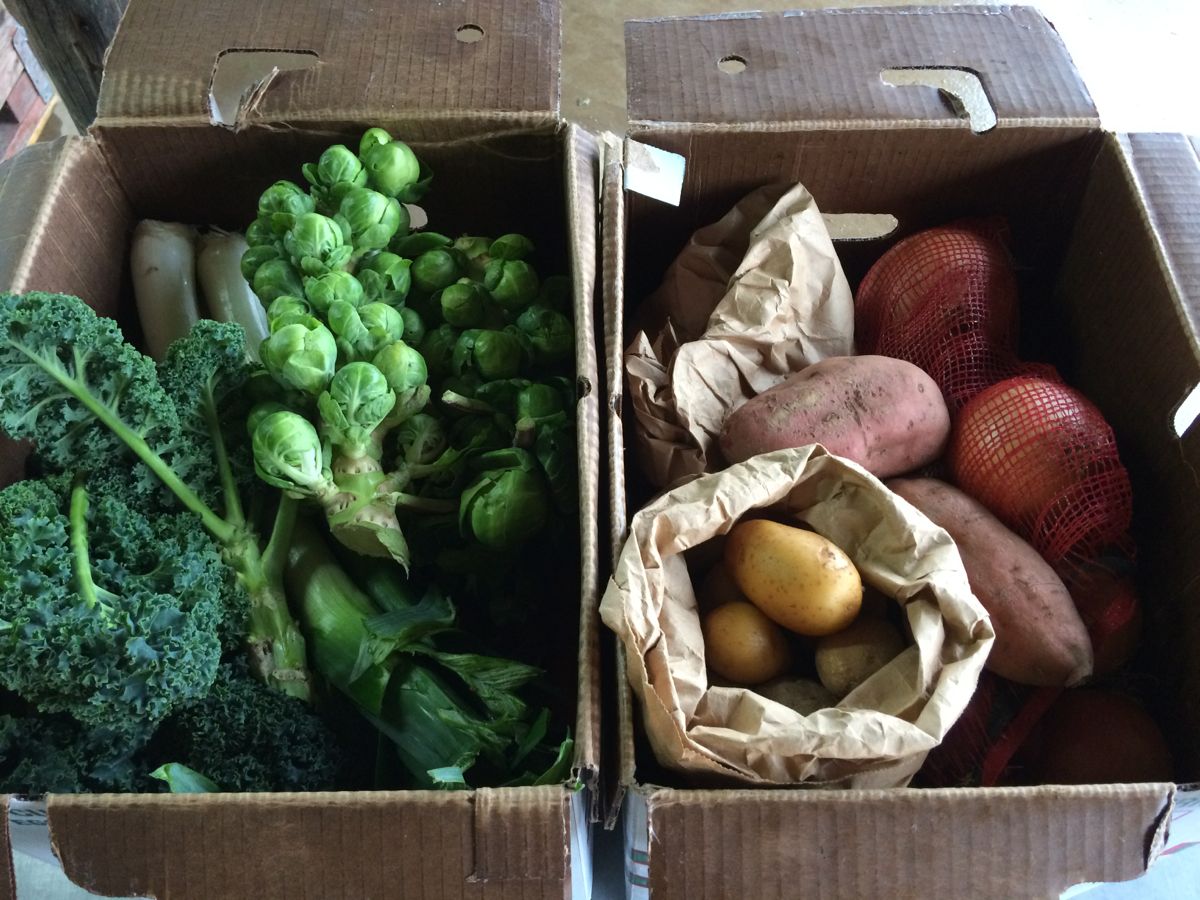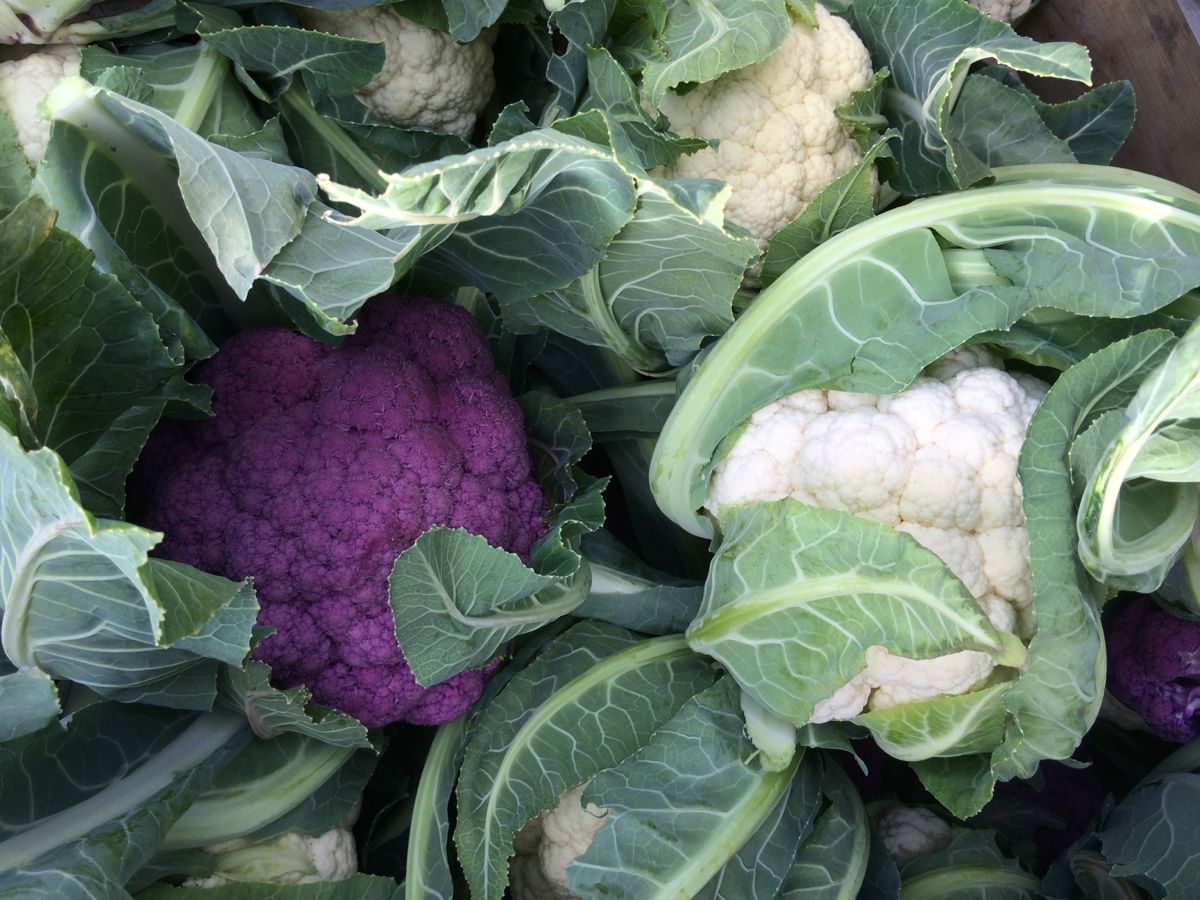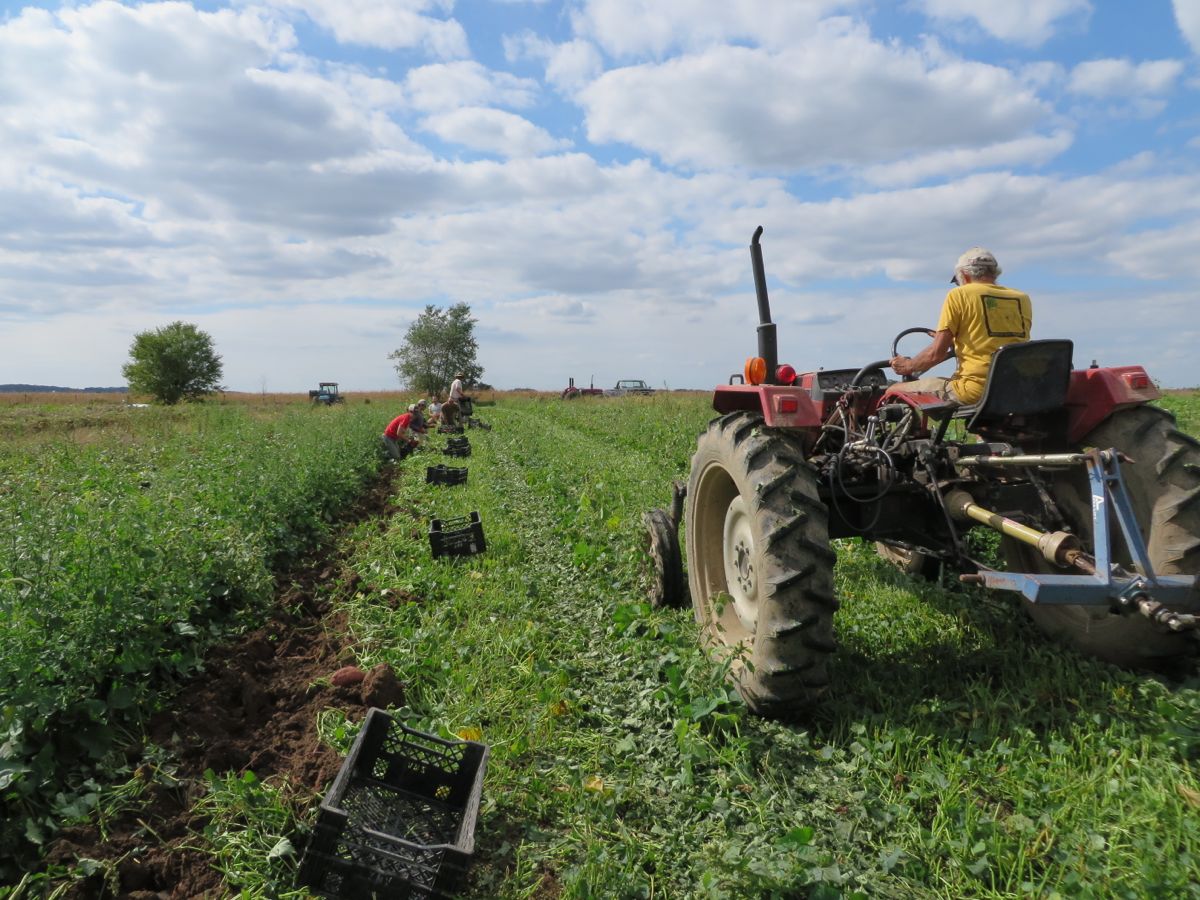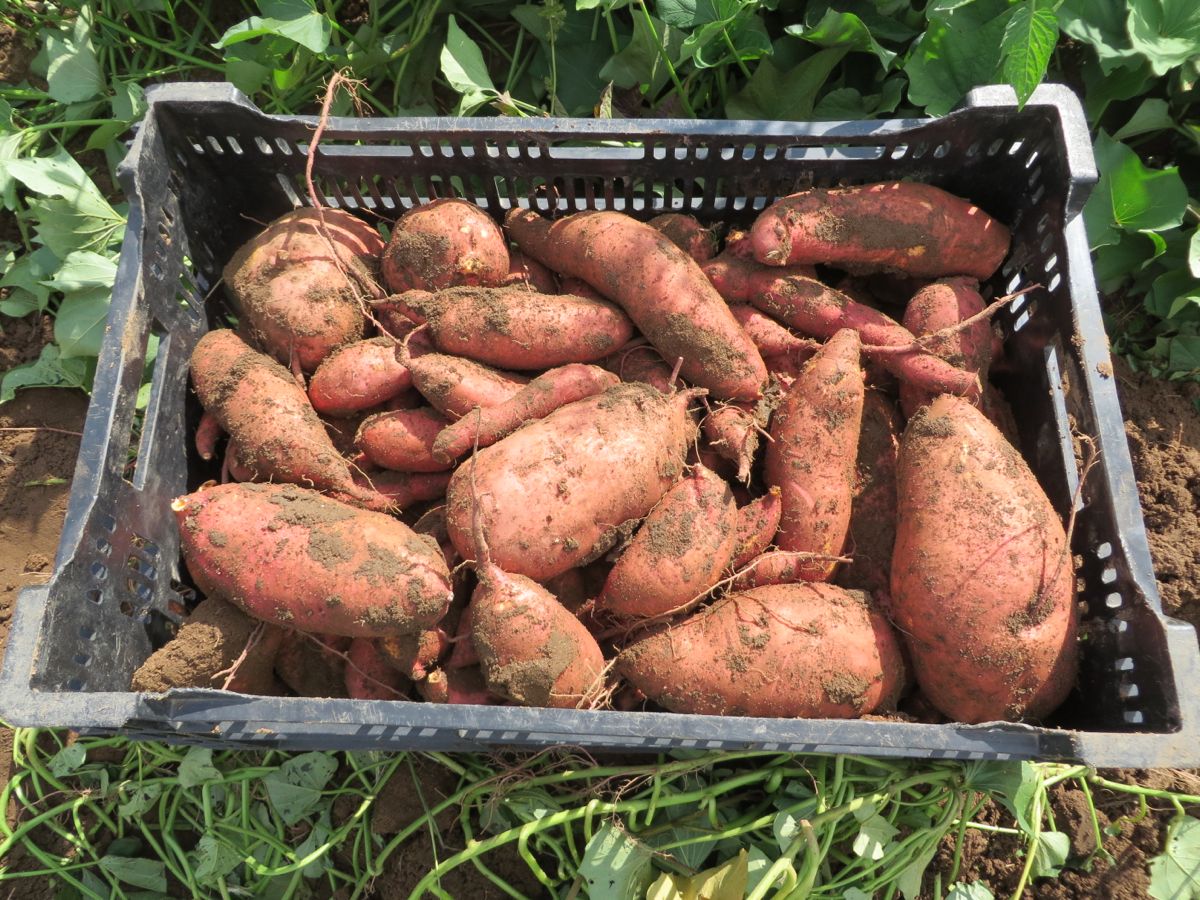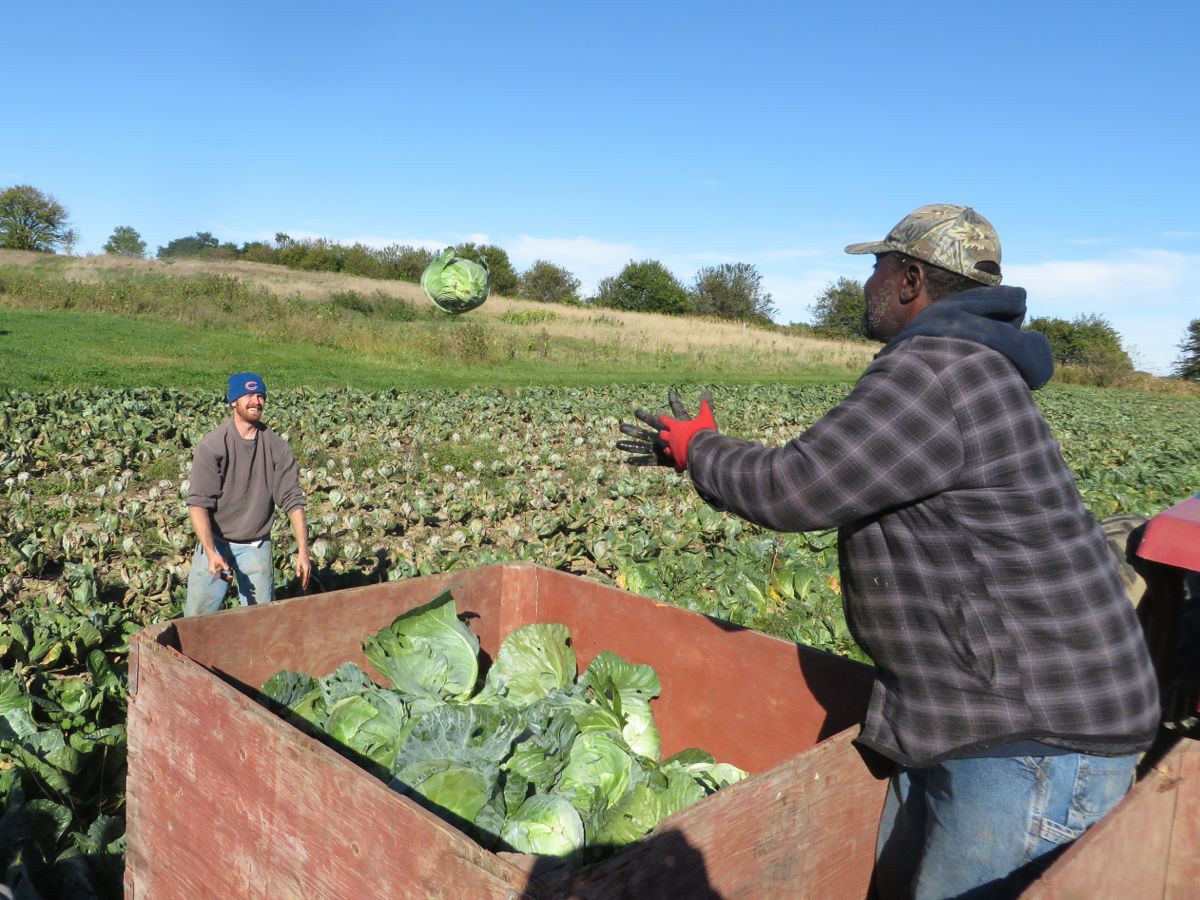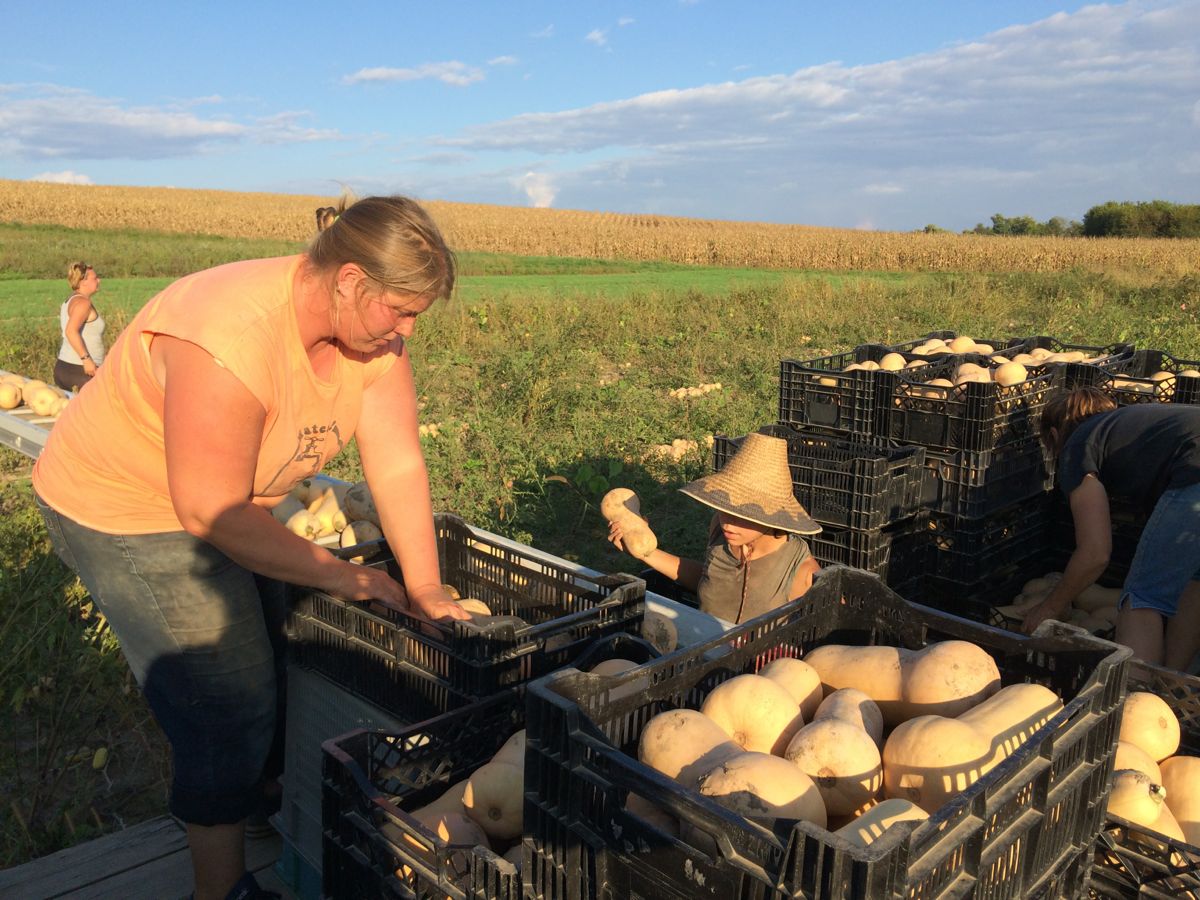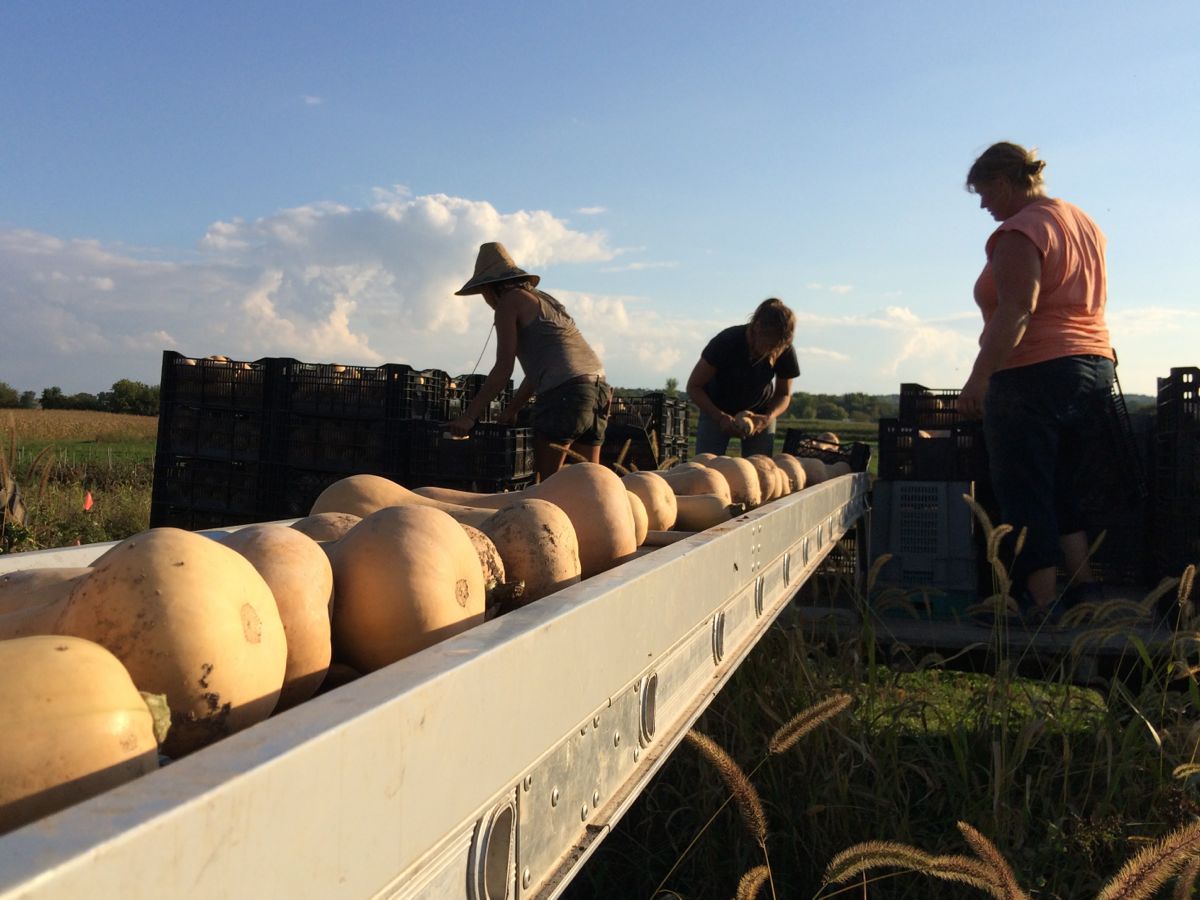Blog
Storage share, Nov. 19/20, 2015
- On: November 18, 2015
 2
2
Things you need to know about your winter share
* Your delivery will consist of two different boxes, labeled “A” and “B”. Take one “A” box and one “B” box. The boxes contain different vegetables.
* Please pick up your boxes on the day of delivery, during the normal hours for your site.
* Outpost members, please get your boxes on Friday. This is the busiest weekend of the year for the Outpost staff, so we cannot ask them to hold boxes past Friday.
* Members at outdoor sites, please carefully put the blankets back on the boxes. That keeps everyone’s produce in good shape.
* The boxes are heavy! It’s OK to take home the packed boxes, then return the empty boxes to your pickup site within two weeks. We’ll swing back and pick them up.
Veggie List and Storage Info (Storage share, Nov. 19/20. 2015)
We hope you enjoy this shipment of veggies! Strategize to use them well, as some will last longer than others.
* This vegetable is the most perishable: kale.
* These are the next-most perishable: Brussels sprouts, cabbage, leeks and onions. Keep an eye on your butternut, potatoes and sweet potatoes. The last two are susceptible to drying out.
* These will last the longest: Beauty Heart radish, beets, carrots, celeriac, garlic, parsnips and rutabaga.
Box “A”
Beauty Heart winter radish, 2
Beets, 3 lb
Brussels sprouts, 1 – 2 short stalks
Carrots, 6 lb mixed colors
(orange 4 lb, yellow 1 lb, purple 1 lb)
Celeriac
Green cabbage
Kale
Leeks, 3 lb
Parsnips, 3 lb
Rutabaga, 1 or 2
Box “B”
Butternut squash, 3-6, ~12 lb
Sweet potatoes, ~10 lb
Red Maria potatoes, ~5 lb
Carolla potatoes, ~5 lb
Red onions, 1 lb
Yellow onions, 4 lb
Garlic, 3
Beauty Heart radishes (round, white with pale green shoulders and bright pink interior) – Refrigerate. The interior color is lovely. Slice thinly and add to salads, cook lightly in mixed vegetable medleys or cut into matchsticks and add to pasta salads. We enjoy grated carrot and Beauty Heart salads all winter.
Beets – Refrigerate in a bag or container. Beets will store for two months or longer.
Brussels sprouts – Pluck from stalks and refrigerate in a bag or container. Eat soon.
Cabbage – Refrigerate. Cut off chunks as needed.
Carrots, orange. Refrigerate in a plastic bag. Will keep for several weeks.
Carrots, yellow and purple. These varieties are pretty AND they taste good. The purple carrots will turn your tongue green. That will get the kids interested.
Celeriac – Will store for months in your fridge. Cut off chunks as needed.
Garlic. Can be stored at room temperature.
Leeks. These need washing. It was getting dark as we prepped them, and we did not realize how much soil was still on them. Refrigerate and eat within three weeks. Leeks are not a long-storage crop. You may need to strip off one or two outer leaves to freshen the leeks before you cook them.
Onions: Store in a cool, dark spot or refrigerate. Protect from light. Exposure to light stimulates sprouting. Refrigerate if you expect to hold for more than one month.
Parsnips (These look like large white carrots.) – Refrigerate in a plastic bag. Parsnips will store for two months but will darken in color. That is a harmless change.
Potatoes, Carola and Red Maria – Can be stored at room temperature or in a cool spot, but must be kept in the dark so they do not turn green. The Carolas are think-skinned and prone to drying out, so keep an eye on them. A loose plastic bag over the paper bag might help, but do not close the plastic bag. Both types will store longer if kept cool. Around 40 – 50 F is ideal. These potatoes were grown by our friends/neighbors Peg and Matt Schaeffer.
Carolas are small to medium potatoes with yellow skin and flesh. Matt says they are his favorite potato and referred me to this description online: “These yellow-fleshed potatoes have moist, creamy-sweet flesh and satisfying texture; a favorite for oven roasting to a rich golden-brown, as well as grilling, steaming, mashing or frying. They add sensational flavor and texture to soups and stews.”
Red Marias are another favorite for the Schaeffers. They are good all-purpose red potatoes with moist, sweet white flesh, good for boiling, mashing, roasting, and salads. Stores well.
Rutabaga (round root, cream-colored with purple shoulders) – Cover and refrigerate. Will store for several months.
Sweet potatoes – These are the Covington variety, and have developed excellent flavor and sweetness. Store at room temperature, no lower than 55 F. Keep them on your kitchen counter where it’s easy to keep an eye on them. I like to keep ours in a paper bag so they don’t dehydrate. Cook promptly if they start to soften. The roots come in a wide ranges of sizes and all are good.
Butternut winter squash – You will receive three to six butternuts, depending on size. They are a mix of varieties: Metro, Waltham, JWS. Store winter squash in a cool, dry place. 50 F is ideal. Do not put in a plastic bag. Inspect your squash frequently and cook promptly if you see any soft spots developing. You can cook, mash and freeze the squash for future use. I find that you can refrigerate cut raw squash for up to one week. This runs counter to the accepted way to store squash, but is useful if you want to cook just half a squash at one time. Try microwaving your squash for one to two minutes before cutting or peeling. This softens the squash and makes large butternuts easier to handle.
What are you cooking for Thanksgiving?
We are creatures of habit when it comes to Thanksgiving. Here are our plans so far: brined roast heritage turkey (Beth), Brussels sprouts with garlic-mustard vinaigrette (Steve), roasted sweet potatoes with garlicky yogurt dip (Sophie), glazed butternut squash (Beth), crunchy carrot-Beauty Heart salad with sesame-seed dressing (Steve), homemade applesauce (Ari), and apple pie (Sophie). We love celebrating Thanksgiving and the end of harvest season!
Menu Ideas
There are many terrific Thanksgiving menus and recipes online right now. Many include vegetables that you will receive in this delivery. Here is a list of the recipe sites I rely on for new vegetable and salad recipes. Search any of these sites if you are stumped about what to do with your storage share.
* The New York Times Cooking app keeps getting better and better. They post appealing recipes and recipe collections every day, and just posted a Thanksgiving menu planner. In my opinion, Melissa Clark is the best NYT food writer. She’s practical and her dishes are always flavorful. David Tanis, Mark Bittman and Martha Rose Shulman are other favorites. The app and recipes appear to be free to the public, but I think you need to be a NYT subscriber to save recipes.
* I like the lively Food52.com site, and always read the community comments.
* Smitten Kitchen is our go-to site for dessert recipes but has excellent veggie recipes too. Plus the blogger is funny. She’s posted a string of interesting recipes this month. Once our work is over, I’m cooking my way through all of them.
* The Kitchn. I found this site after wandering over from their Apartment therapy home-design site. Good recipes.
* 101cookbooks. Always has good vegetarian and whole-grain recipes.
* Finally, remember that we have access to the entire catalog of Local Thyme recipes all winter. Check them out for Thanksgiving ideas.
Do you have favorite menu sites for fall and winter recipes?
If so, please share in a comment!
Final box + Tipi Secrets Revealed
- On: November 11, 2015
 2
2
This is the final box of our regular CSA season. Thank you so much for joining our adventure this year. We hope you have enjoyed the food and the experience. We think about our community of eaters each week as we harvest and prepare your produce. We cannot thank you enough for the trust you have placed in us.
It was a good season. Too wet in spring, too dry in summer. In other words, quite normal. November weather usually leaves us battered and ready to hole up inside for the winter. Not this year. The mild fall has been a blessing, and we end the season feeling like spring chickens. There are still housekeeping details to wrap up the season, so we will be in touch again in the next few weeks.
– 2015 survey, coming soon.
– 2016 CSA registration, coming soon.
Please return all boxes to your pick-up site.
We will retrieve them next week. It is best to unpack this week’s produce and leave the empty box behind.
Storage share members …
We sent you an email on November 4 with delivery dates. Contact us if you didn’t receive that email.
Tipi Secrets Revealed
I tend to curate the images we share, focussing on our farm’s beauty and productivity. To end the season, let’s share a few things we’ve never shown you before. The common thread? Each of these images represents a moment of joy for our crew.
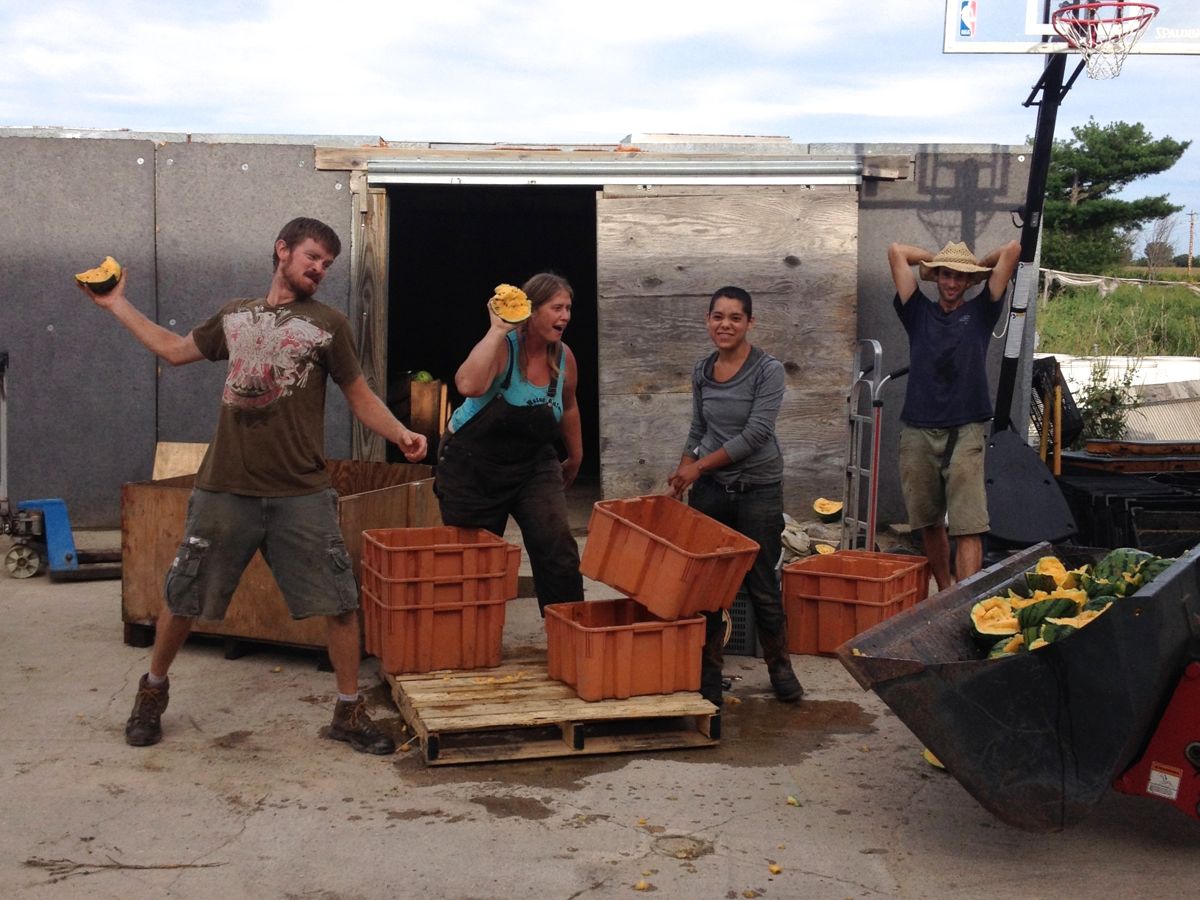
Last summer, there were reports of problems with the orange watermelons. Not many, but enough to keep us from shipping the final melons from that harvest. Not sure what to do with them, we left them in the cooler until it was clear they destined for the compost heap. (Haven’t you done that with leftovers in your fridge??) Billy, Maggie, Boi and Jon cleaned out the remnants and the job turned into a melon-smashing spree. I have never heard them laugh so hard. Photo by Bri Fiene.
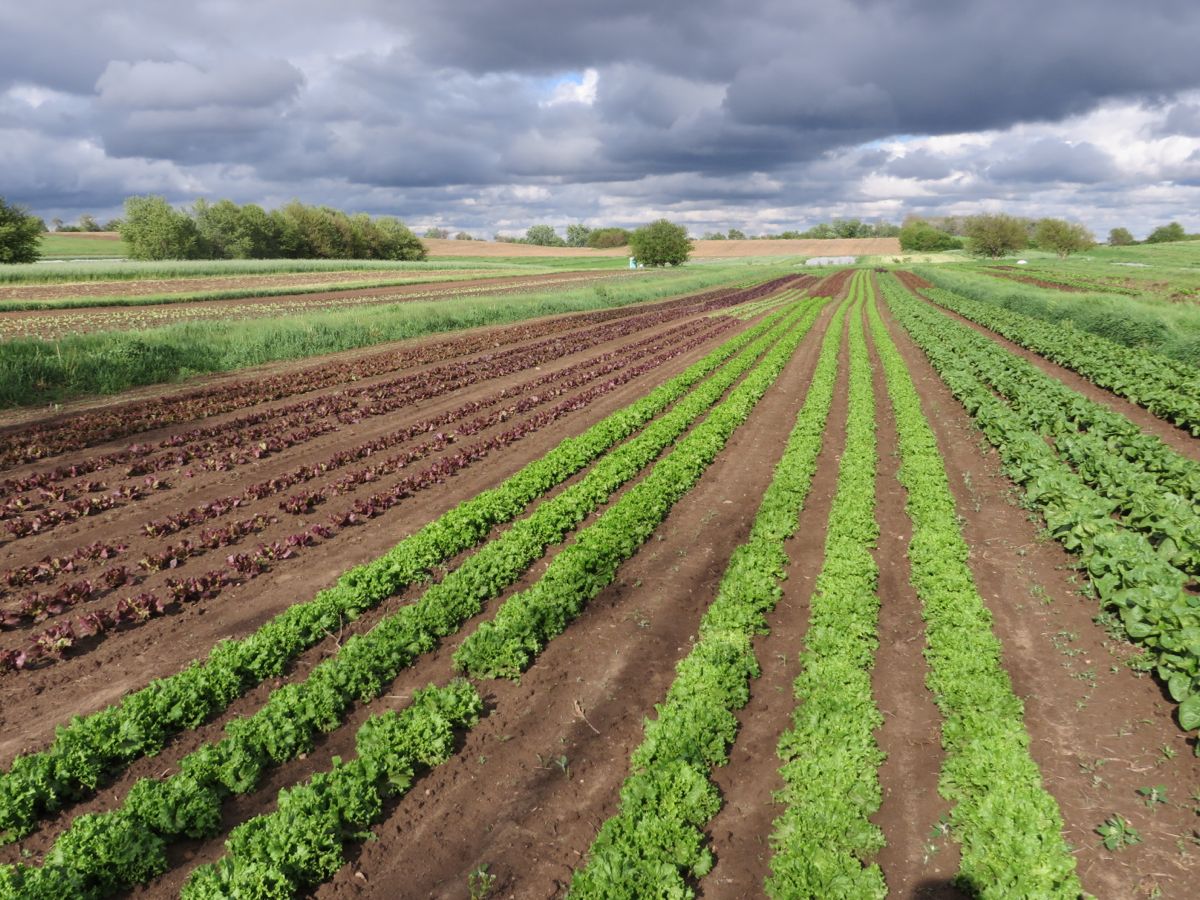
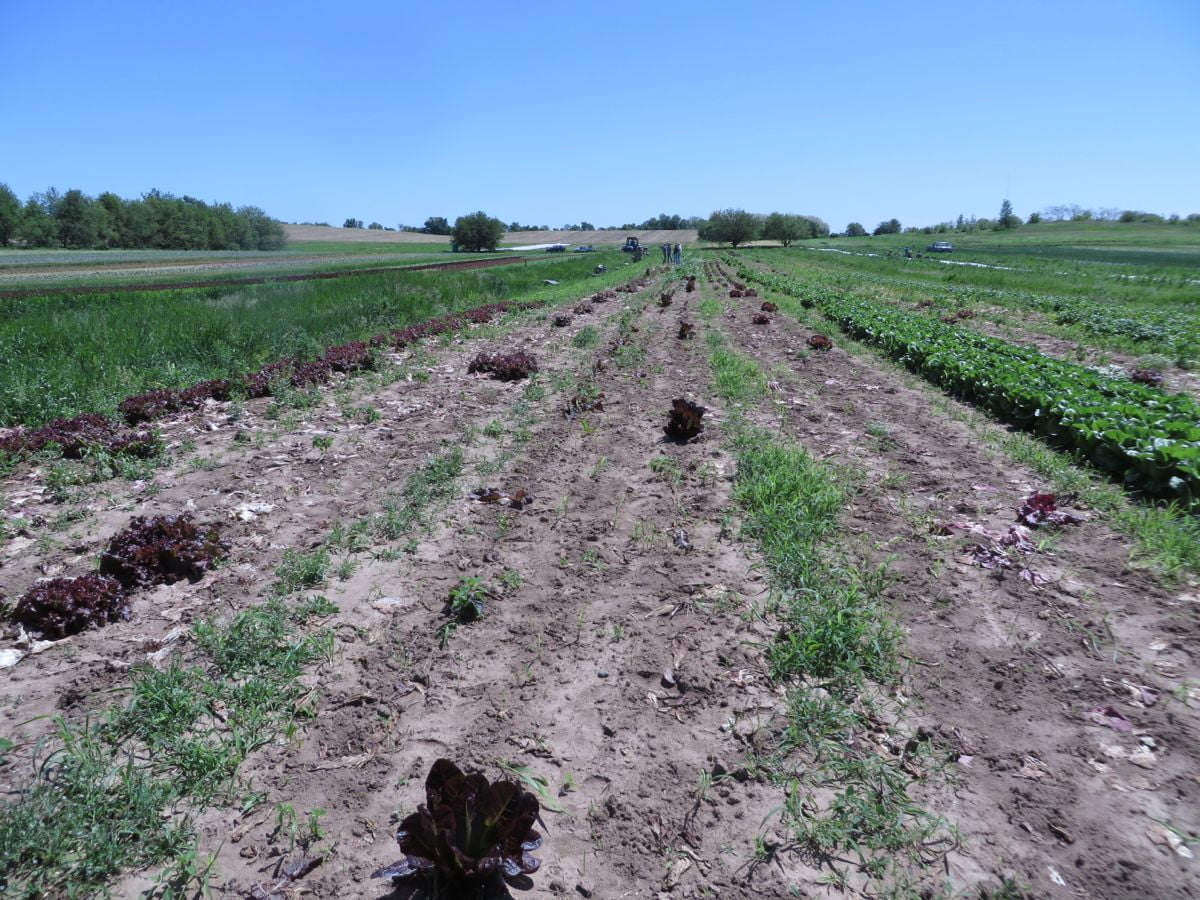
Young lettuce fields are photogenic and filled with promise, so we usually share photos like the top one above. Reality is that many of those lettuce heads will not be good enough to harvest. Rot, insects, bolting, tip burn, rain damage – there are many, many ways for lettuce to go bad. In the lower photo, we have harvested almost every single head. That is rare and unusual, and made our lettuce crew very happy. Maggie “Lettuce Queen” Schley still talks about this particular field.
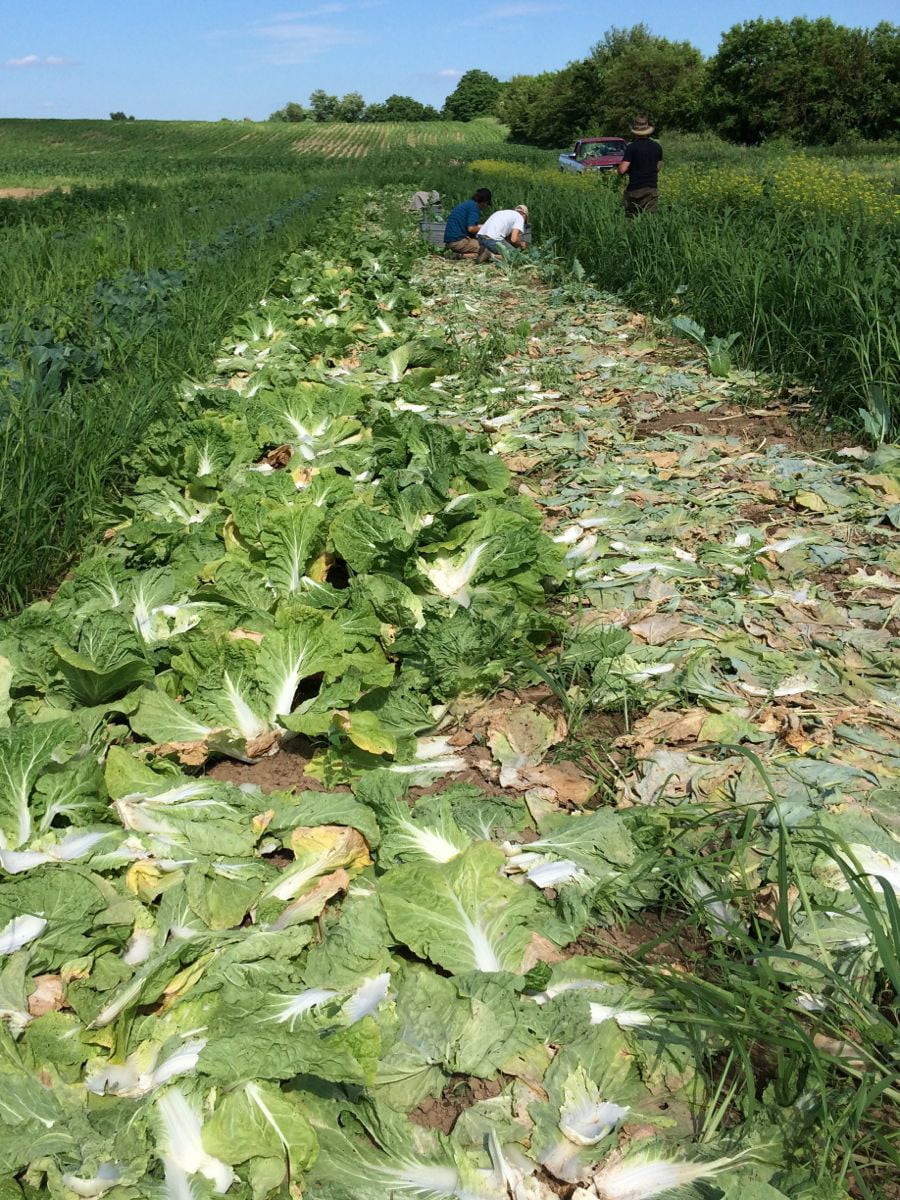
I could fill the newsletter with scenes like this napa and kohlrabi harvest but it would be bewildering for readers. That was a terrific field but looks like a scene of wanton destruction.
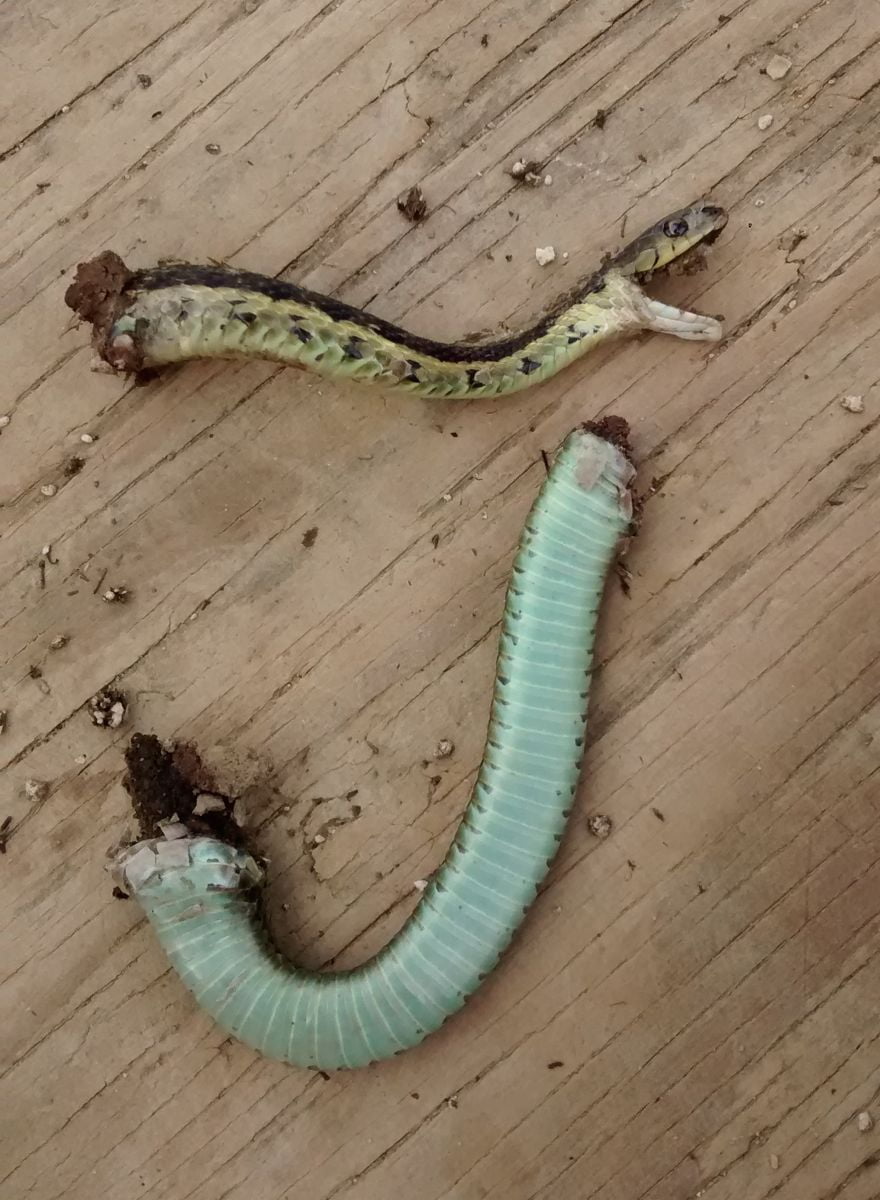
Oops. We felt bad after mowing the sweet corn. Madeleine noticed something shiny at the edge of the field and found these remnants of a garter snake. Gage tanned the skin for Madeleine, then ate the snake. He says it tasted like chicken, with the consistency of a rubber band. He is a unique and resourceful guy. OK, that was an interesting episode rather than a moment of joy.
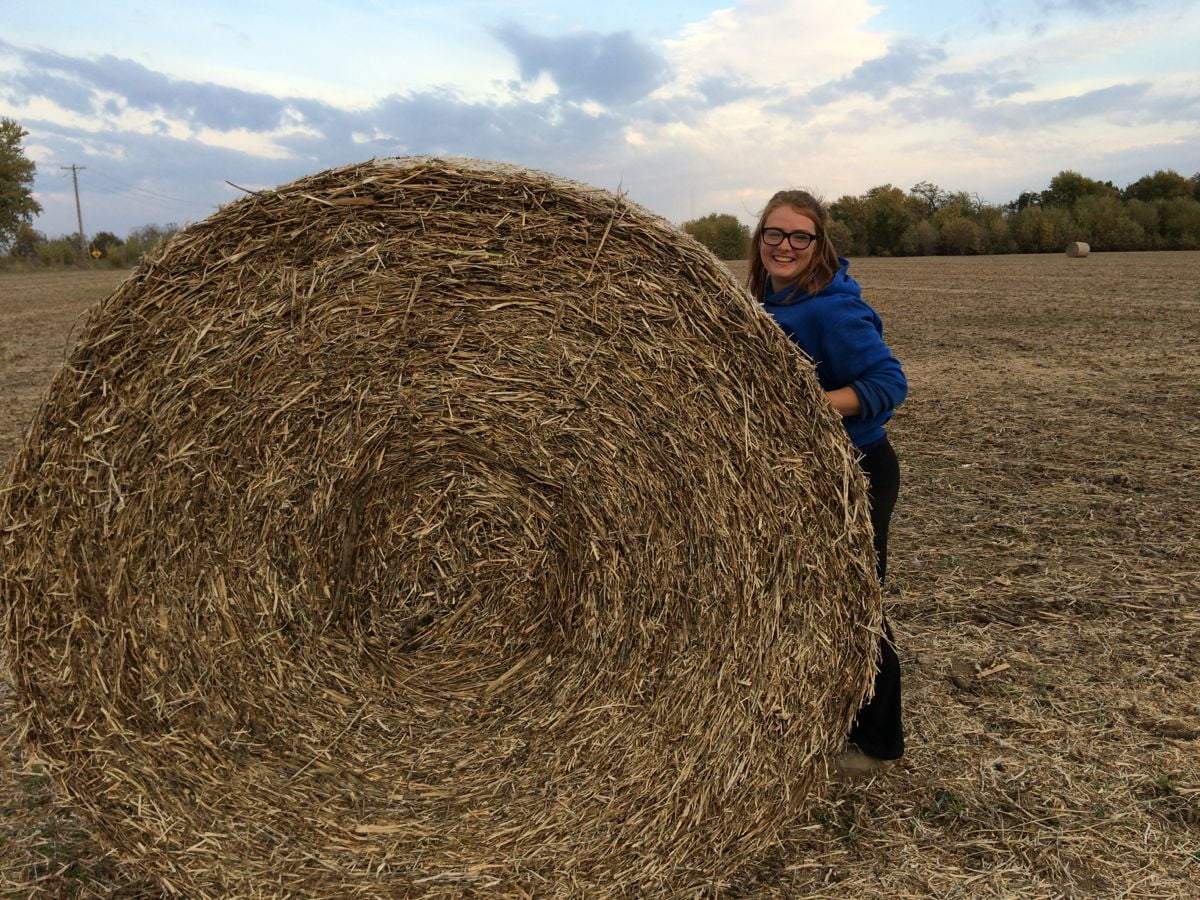
Our neighbors baled their corn stalks a few weeks ago. There was endless discussion among our crew about whether it’s possible to leap up onto the bales unassisted. Here are three answers:
That’s it! Enjoy your winter and we will see you next spring. Beth and Steve
Veggie List and Veggie Notes (Nov. 12/13, week #26, green EOW)
Red cabbage
Sweet potatoes, 2 – 2.5 lb
Brussels sprouts, on the stalk
Butternut squash
Leeks, 1.5 – 2 lb
Carrots, 2 lb
Beauty Heart radish
Garlic
Next week’s box will probably contain … Wait! The next CSA box will be on May 19, 2016. Put it on your calendars. Our best guess for that box is asparagus, spinach, lettuce, green garlic, potatoes, arugula, radishes, and rhubarb.
Beauty Heart radishes (round, white with pale green shoulders and bright pink interior) – Refrigerate. The interior color is lovely. Slice thinly and add to salads, cook lightly in mixed vegetable medleys or cut into matchsticks and add to pasta salads. We enjoy grated carrot and Beauty Heart salads all winter.
THIS WEEK’S RECIPES
Comforting Classics
Confetti of Watermelon Radish and Carrot
Leek Bruschetta
Black Bean Burrito with Chipotle Sweet Potatoes and Red Cabbage
Sweet and Sour Braised Red Cabbage
Steamed Brussels Sprouts with Butter and Thyme
Winter Squash Soup with Gruyere Croutons
Outside the Box Recipes
Hazelnut Butter and Beauty Heart Radish Sandwich
Beer, Ham and Cheese Chowder with Leeks
Sweet Potato Polenta
Seared Red Cabbage with Crumbled Blue Cheese Dressing
Brussels Sprouts Braised in Nutmeg Cream
Butternut Squash Soup with Ham and Peas
Kitchen Sink Recipe
Quick and Easy Meal Idea
Final week for purple EOW
- On: November 07, 2015
 0
0
The calendar says “fall” but the weather says “summer.” I am sure you have noticed. Nonetheless, we are near the end of our CSA season.
This week, November 5/6 = Final box for our purple EOW members. Thank you!
Next week, November 12/13 = Final box for weekly members and for green EOW members.
Storage share members – I sent you an email yesterday to confirm that you are registered, and with info about the delivery schedule.
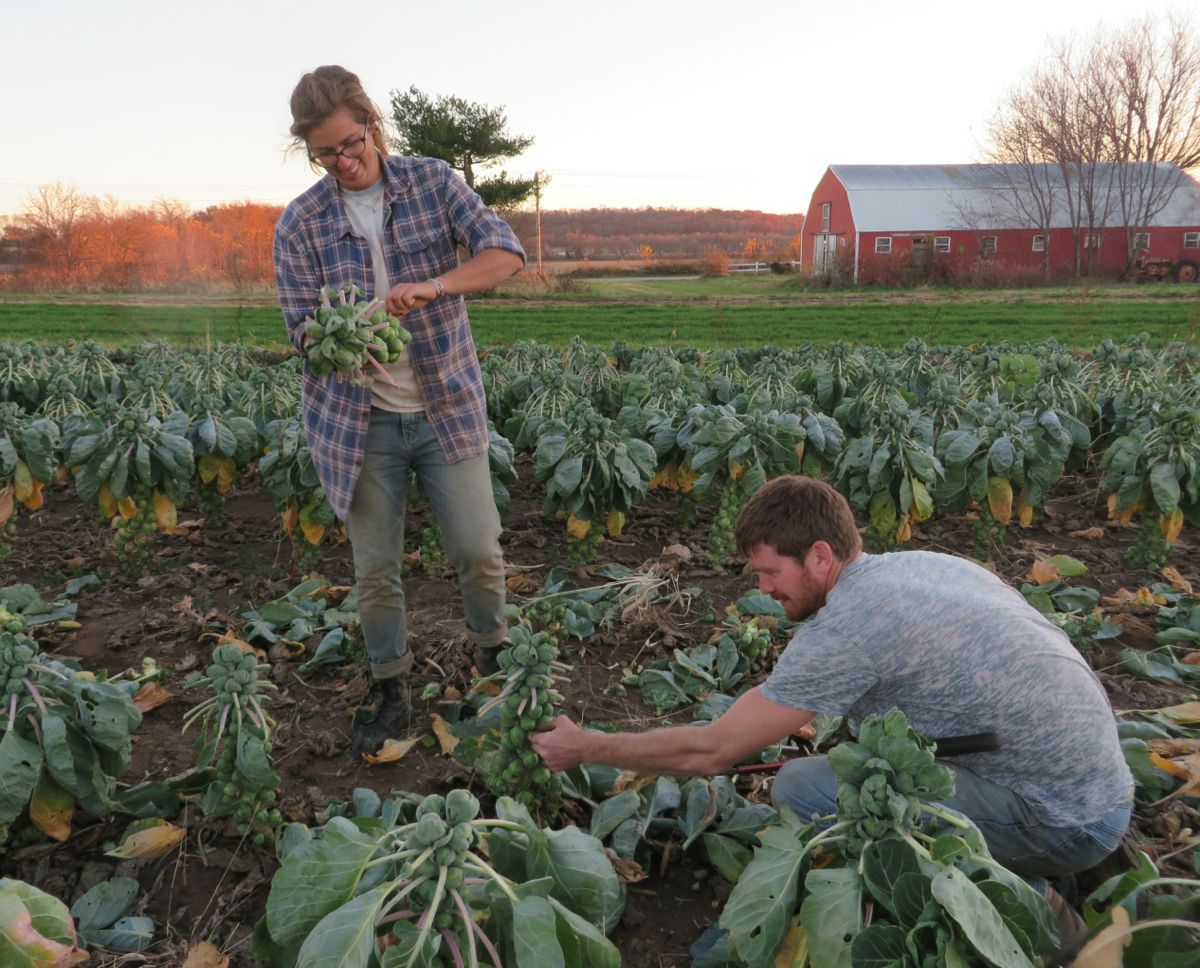
Kelcie and Billy harvest Brussels sprouts in shirt sleeves. That’s not shabby.
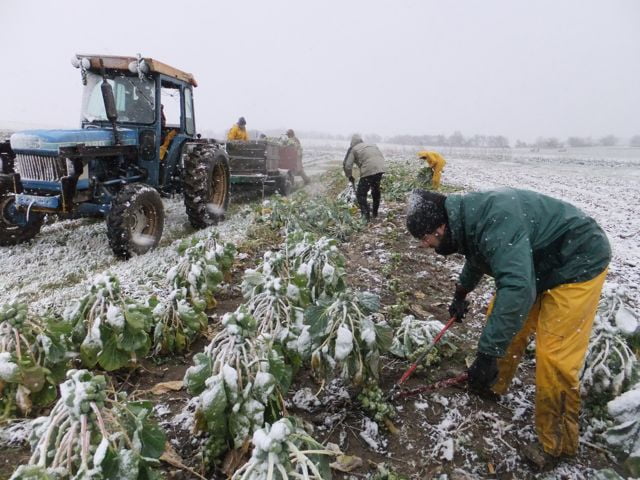
Compare with our 2013 Brussels sprouts harvest. What a difference. We cut the stalks and took them back to the warm barn to pluck the sprouts from the stalks. It’s impossible to do outside when it’s that cold.
Veggie List and Veggie Notes (Nov. 5/5, 2015, week #25, purple EOW)
Brussels sprouts
German butterball potatoes, 3.5 lb
Butternut squash
Beets, 2 lb
Celeriac
Yellow onions, about 2
Garlic
Cauliflower
OR small cauliflower + Romanesco
OR small cauliflower + broccoli
Next week’s box will probably contain sweet potatoes, Brussels sprouts, leeks, winter squash, red cabbage, carrots, Beauty Heart radish and garlic.
Brussels sprouts – We are sending the sprouts on the stalk. Pluck from the stalk soon to keep the sprouts from wilting. Saves space in your fridge too!
If you are a new CSA member, please approach Brussels sprouts with an open mind. Many of us grew up eating awful, overcooked Brussels sprouts. These Brussels sprouts are completely different.
Here is our method to cook Brussels sprouts: Wash the sprouts and trim the cut ends. Cut an X in the stem end of large sprouts. Cut a single slit in small or medium sprouts. This does two things. It helps the Brussels sprouts cook evenly, plus it allows them to soak up any marinade or dressing. Place sprouts in a pot with one inch of water in the bottom and steam until tender, 7 to 10 minutes. If the sprouts are uneven in size, then set aside the smallest ones and add to the pot after the larger ones have cooked for a few minutes. Don’t overcook them! You can also oven-roast Brussels sprouts. Here are a few dressing ideas for cooked sprouts:
– Sherry vinegar/olive oil/Dijon mustard/garlic/white wine/salt and pepper. This is our favorite, especially when you combine the Brussels sprouts with slivered peppers and thinly sliced onions. Delicious warm, cold, or at room temperature.
– Balsamic vinegar/olive oil/garlic/salt and pepper
– Lemon juice and zest/melted brown butter/poppy seeds/white wine/garlic/salt
German butterball potatoes – These are from our friends Peg and Matt Schaefer of Sandhill Family Farms, and are the potatoes our crew helped harvest a few weeks ago. Matt says German Butterballs good all-around potatoes with outstanding flavor. This variety was the first place winner in Rodale’s Organic Gardening “Taste Off.” Best uses are roasted, boiled or fried. We boiled small ones in salt water and they were excellent. Everone in our house chose a different accompaniment for the potatoes; sriracha mayo (Ari), garlic mayonnaise (me), kimchi (Steve) and parmesan cheese (Sophie).
Butternut squash (tan, cylindrical winter squash) – This “Metro” variety has cured very nicely, with good sweetness, flavor, and color.
Celeriac (knobby, round, bizarre-looking vegetable which smells like celery) – Flavorful celeriac is good raw or cooked. It is excellent in mixed roasted veggies or in soup. It’s especially good in cream soups, alone or mixed with potatoes. Grated raw celeriac is a great starting point for winter salads. Celeriac will store in your refrigerator for months. Cut off chunks as you need them. Peel before using.
THIS WEEK’S RECIPES
Comforting Classics
Creamy Cauliflower Potato Soup
Butternut Pie or GF Butternut Pie
Brussels Sprouts with Pecan Brown Butter
BSK Breakfast Potatoes
Beet, Gorgonzola and Toasted Walnut Salad
Apple Celeriac Waldorf
Outside the Box Recipes
Cauliflower Polonaise
Winter Squash Galette
Whole Grain Spaghetti with Brussels Sprouts and Mushrooms (included are vegan substitutions)
Bangers and Mash
Ginger Glazed Beets
Celeriac, Smoked Mozzarella and Prosciutto Salad
Kitchen Sink Recipe
Brussels Sprout and Butternut Squash Dressing
Quick and Easy Meal Idea
Dwindling palette
- On: October 28, 2015
 1
1
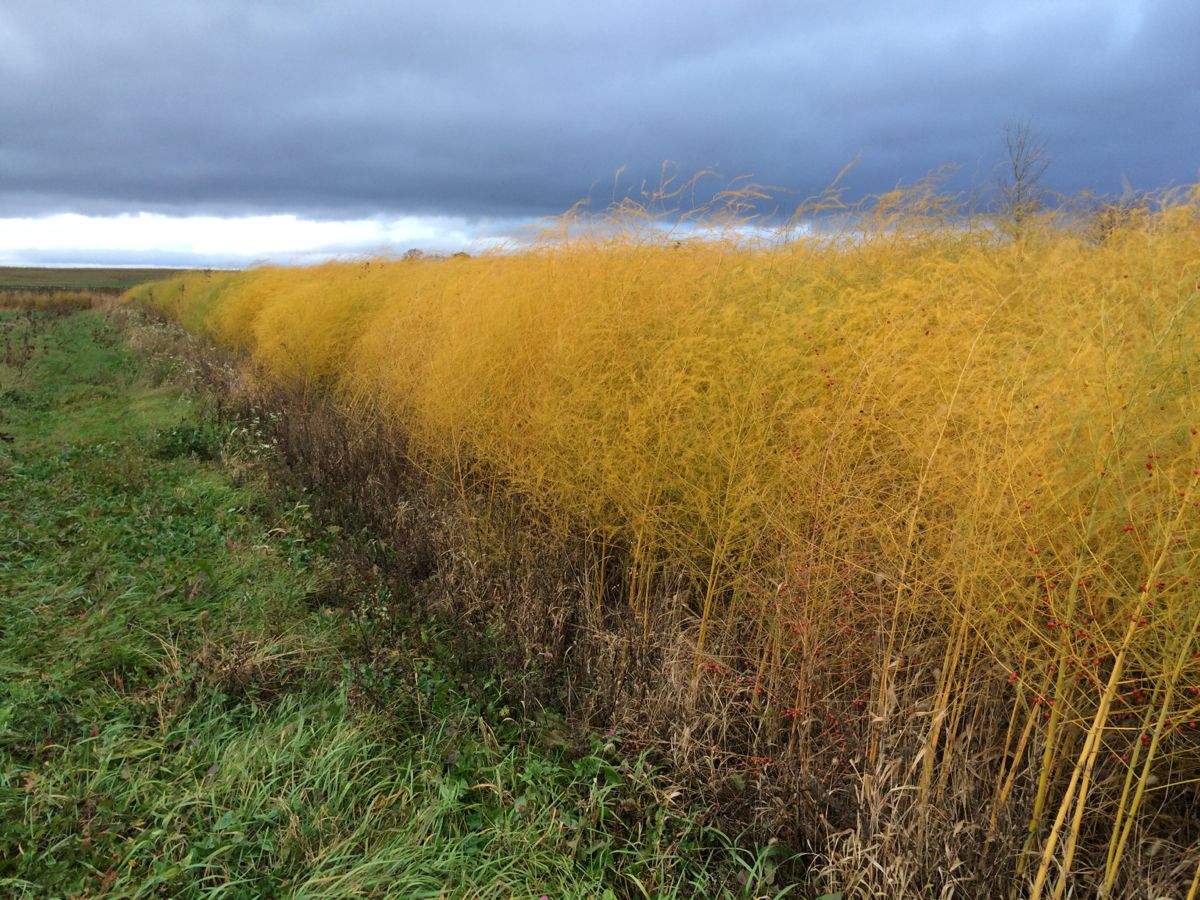
The farm colors are dwindling but beautiful. Asparagus fronds are brilliant yellow for just a week or two.
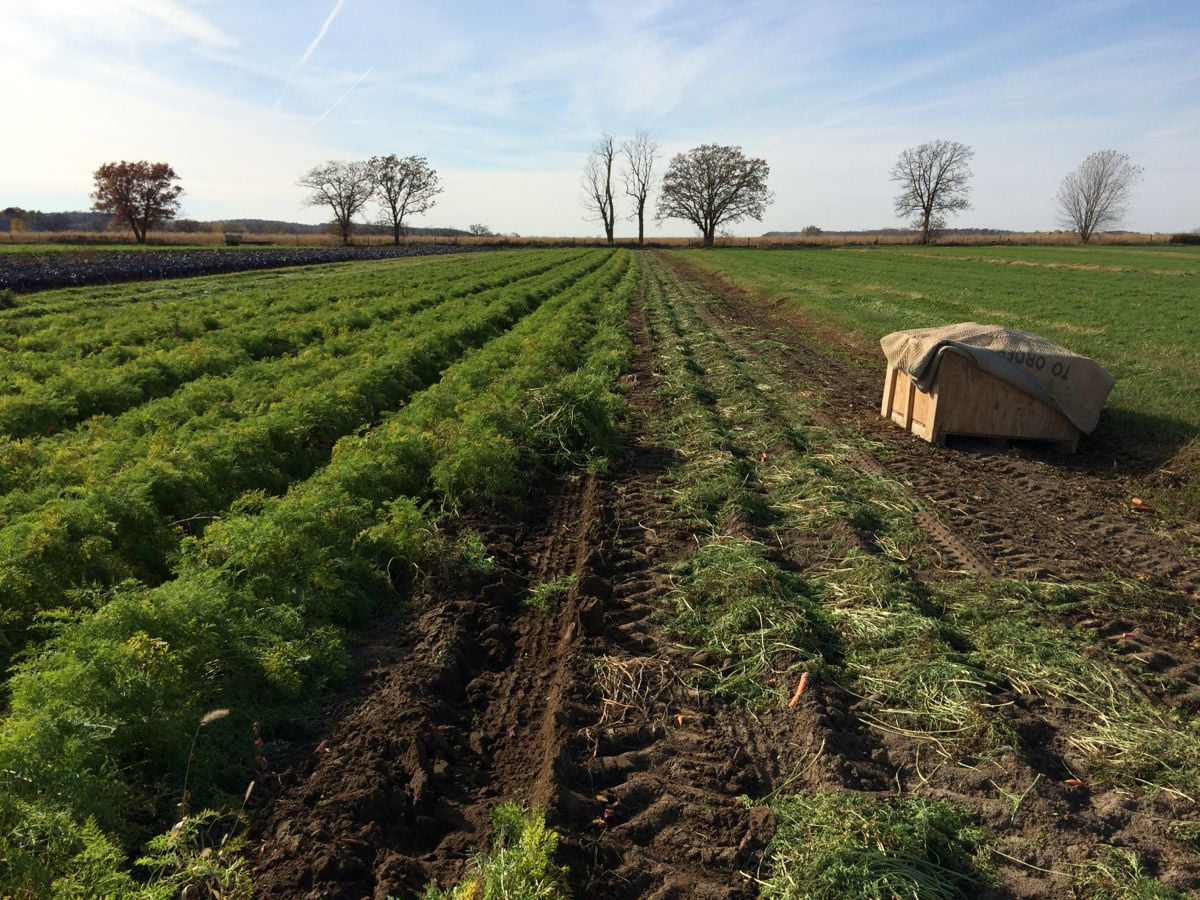
Carrot-green at left, cover-crop-green on the right. We’ve begun harvesting carrots to store and sell through the winter but have a long way to go.
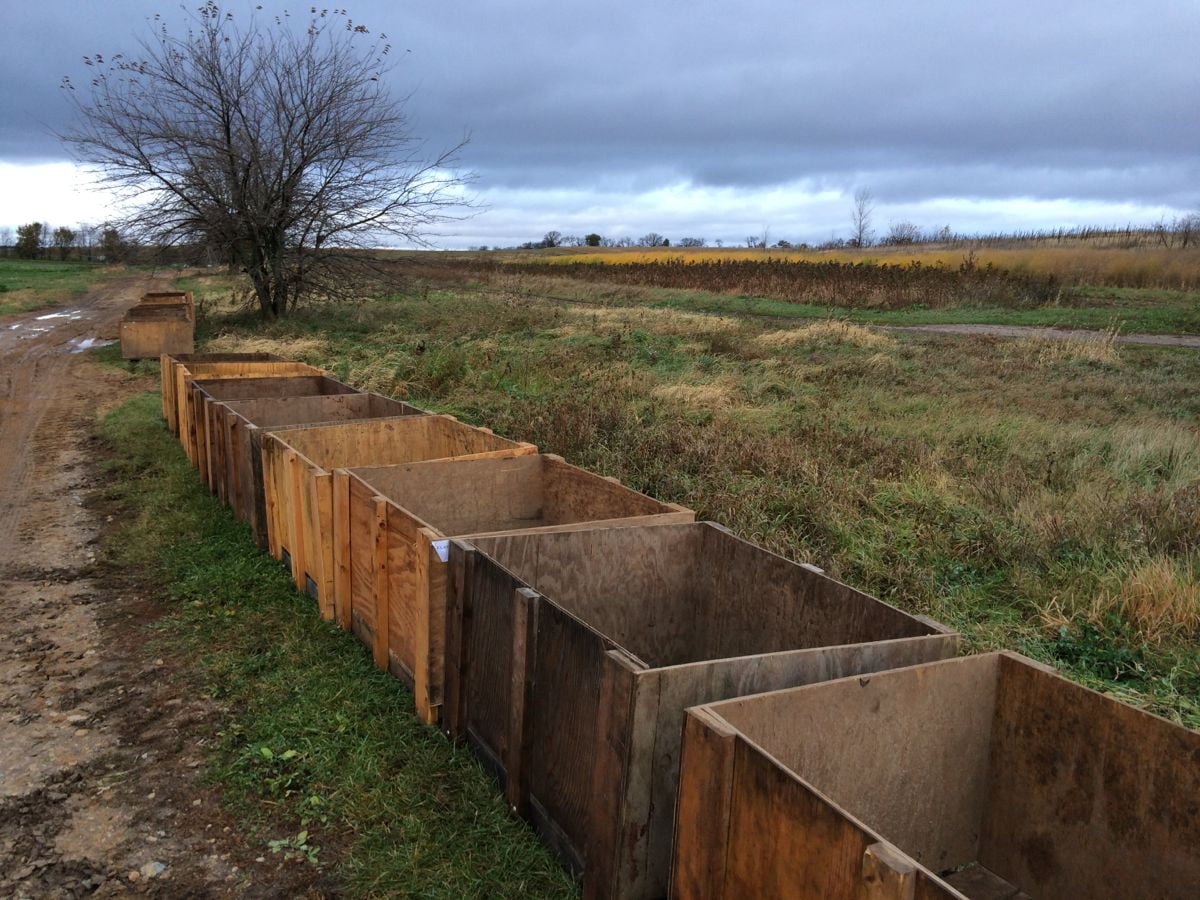
Empty bins lined up and ready for carrots.
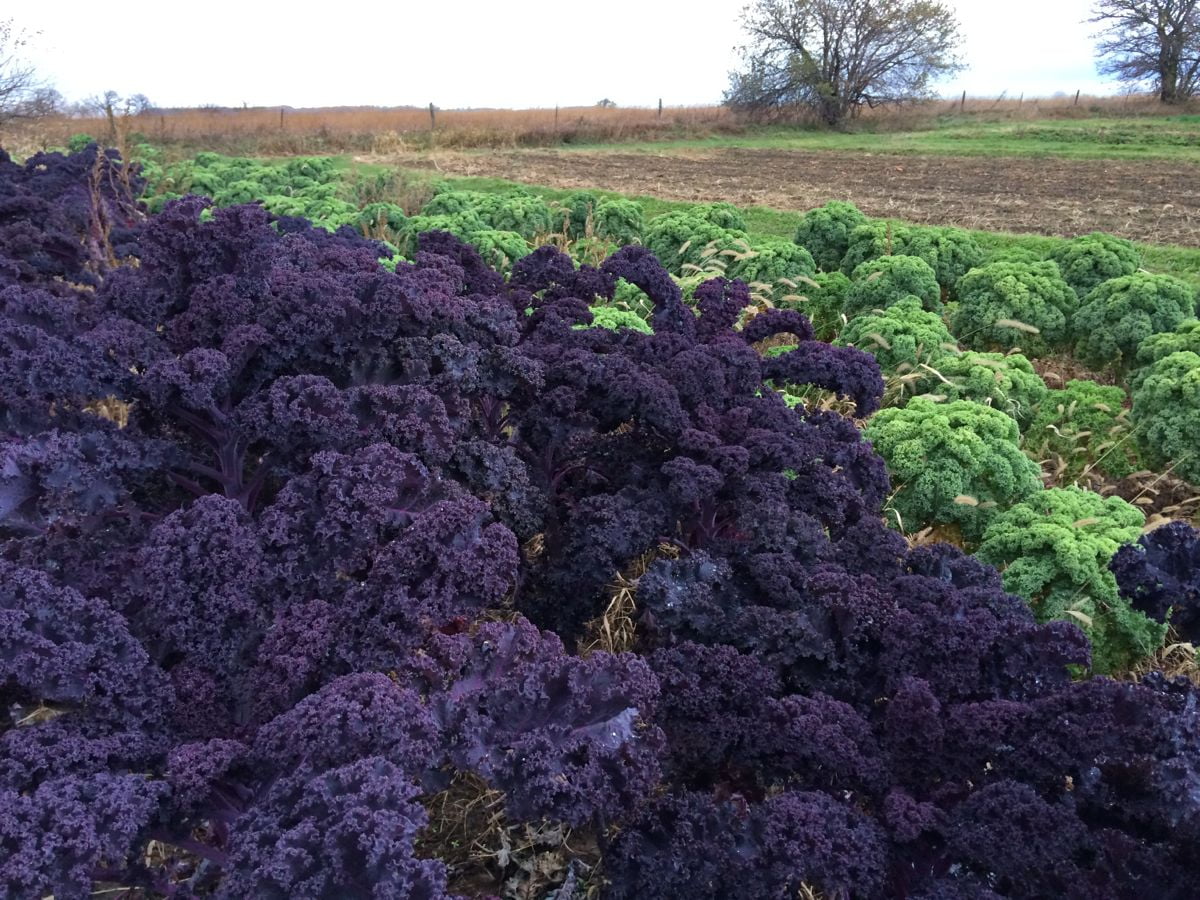
The red and green kale are hanging in there. They can handle a lot of cold without damage.
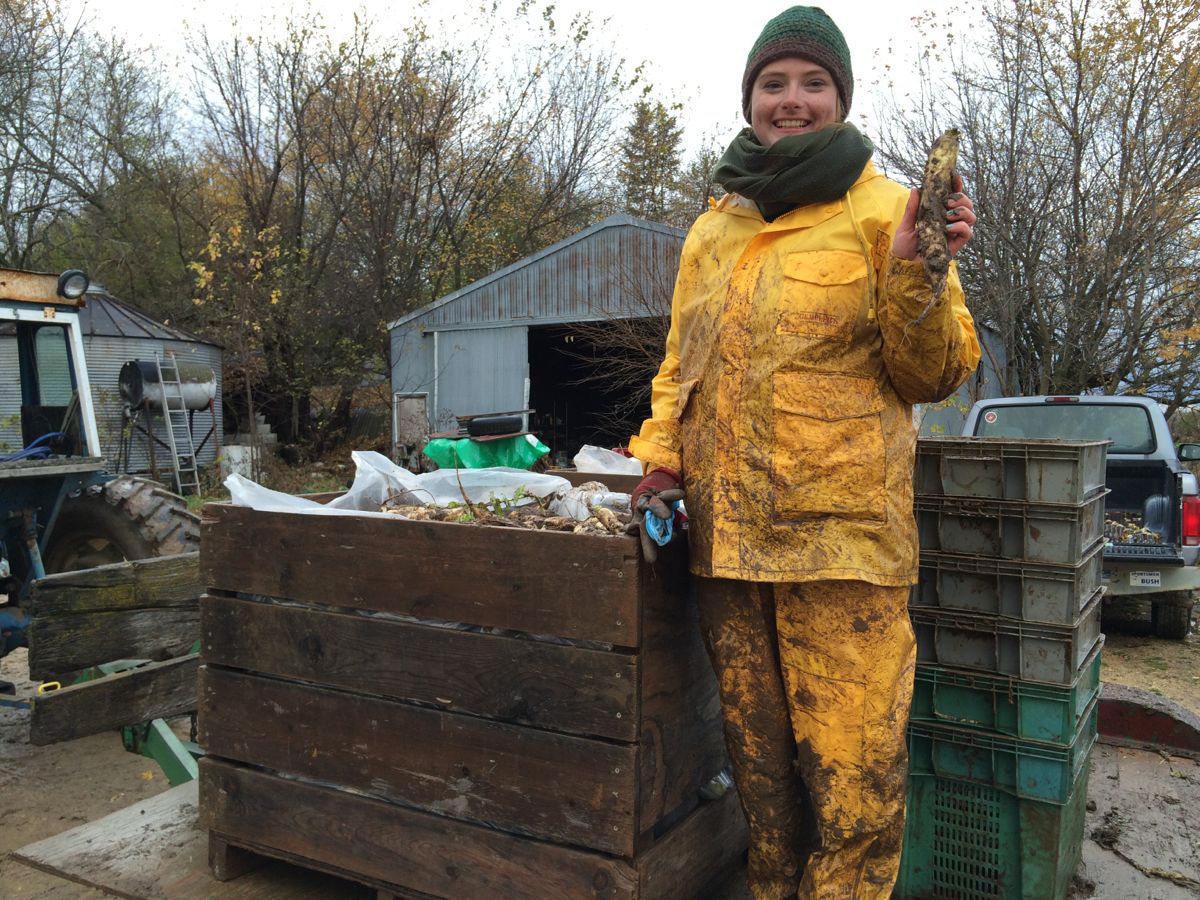
Our workers are the brightest thing in the landscape in their rain gear. Caitlyn after a muddy daikon harvest.
Delivery count-down
November 5 = final delivery for purple EOW members
November 12 = final delivery for weekly and for green EOW members
Last chance to get a 2015 receipt
Go to this link to send yourself a receipt for your 2015 CSA shares. I need to wrap up the books for the year, and will disable the receipt link in about one week.
Veggie List and Veggie Notes (October 29/30, week #24, green EOW)
Butternut squash OR sweet potatoes
Broccoli, a modest amount
Cauliflower OR Romanesco broccoli
Red mustard greens, 1 bunch
Carrots, 2 lb
Parsnips, 1.5+ lb
Kohlrabi, 1
Frying peppers, about 5
Yellow onions, about 2
Garlic
Next week’s box will probably contain German butterball potatoes, winter squash, Brussels sprouts, beets, onions, celeriac, cauliflower OR Romanesco broccoli, and more.
Butternut squash – These are the ‘Metro’ variety again.
‘Beauregard’ sweet potatoes – Here are a few things we’ve learned about sweet potatoes:
– For best flavor, cook your sweet potatoes so they brown and caramelize. We have a simple, favorite way to roast sweet potatoes. We used to prepare sweet potato fries. Now we just quarter the potatoes, rub with olive oil, dust with salt and place cut-side-down on a cookie sheet. Roast in a 450 F oven without turning until soft. The flavors will caramelize (like sweet potato fries) but preparation is simpler and the cooking time less exacting. Slender sweet potato fries go from undercooked to overcooked in the blink of an eye. Larger slices are less exacting, and therefore are easier. Small sweet potatoes can be cut just in half. Jumbos will need to be chopped into pieces. Otherwise, they will take a long time to cook.
– Store your sweet potatoes at room temperature. They suffer chilling injury below 50 F.
– The sweet potatoes we grow require slightly longer cooking than ones from the supermarket, perhaps because they contain higher moisture so soon after harvest.
– Sweet potatoes are good at any size. We have cooked everything from tiny to jumbo and consistently find that all sizes taste good.
Red mustard greens (bundle of red and green leaves) – These might be the final greens for the season. We’ll see. We grew two types of red mustard greens this year, one of which looks like red bok choy. As usual, you can eat both the stems and leaves.
Parsnips (tapered, cream colored roots) – Those long, white roots are not carrots, they are parsnips. The two vegetables are related. When cooked, parsnips are sweet and starchy. For the best flavor, brown them to caramelize the sugars. Here are a few ideas for parsnip preparation:
– Caramelize the parsnips by roasting them in a vegetable medley.
– Parsnip fries are delicious: cut like French fries, coat very lightly with oil, place on a cookie sheet and roast in a hot oven until brown and cooked through.
– Try substituting grated parsnips in a potato pancake recipe. They brown beautifully and are very tasty.
– Steve loves pan-fried parsnips with onions and garlic.
Kohlrabi (pale green, round vegetable with thick skin) – Crunchy and sweet, kohlrabi is a great addition to salads.
Storage: Kohlrabi bulbs will store for a month in the refrigerator.
Uses: Kohlrabi are good peeled and eaten out of hand, or added to sandwiches. It is good mixed into salads, or prepared as a salad on it’s own. You can grate it, slice it, or cut it into matchsticks. It’s also good cooked. If you have it, the Asparagus to Zucchini cookbook has a long list of kohlrabi suggestions.
Frying peppers (sweet red or green peppers) – Eat these soon! We don’t think they will store for long.
THIS WEEK’S RECIPES
Comforting Classics
Savory Butternut Scones
Cheesy Orecchiette with Ricotta and Mustard Greens
Braised Brisket with Parsnips
Tangy Kohlrabi Slaw, with Cumin and Honey Dressing
Bourbon Ginger Glazed Carrots
Roasted Romanesco
Outside the Box Recipes
Butternut Squash Tahini Spread
Smoked Pork and Quinoa Soup with Mustard Greens
Parsnip Pancakes
Smoked Trout Salad Sandwich with Kohlrabi, Apple and Onion, on Rye
Curried Carrot Pilaf with Kohlrabi
Decadent Cauliflower Puree
Kitchen Sink Recipe
Mashed Fall Vegetables with Bacon Vinaigrette
Quick and Easy Meal Idea
Win-win
- On: October 21, 2015
 0
0
We finessed an interesting deal this week. As I’ve explained before, we buy potatoes from organic farmers that we trust. When we started our CSA, I made Steve agree that we would grow everything except potatoes. He would want every piece of equipment needed to grow potatoes, and it’s a big line-up. Our friends/neighbors Peg and Matt Schaeffer of Sandhill Family Farms have a bumper potato crop this year but not enough employees to get them harvested. We have an unusually large crew working for us this fall. We made a deal – our crew will help dig the potatoes, and we’ll buy them at a reasonable cost. They have nice varieties; German butterballs for the November 5/6 box, and Carolas and Red Marias for the storage share. Matt dropped samples at our house and we enjoyed a mini potato-cooking festival.
Oddly, the toughest part of the deal was finding enough containers to hold the potatoes. Every economy has its currency. Right now, both our farms are running short of plastic crates for harvest. We filled all ours with sweet potatoes and winter squash. They filled theirs with potatoes. We scrounged and washed out every crate available while Matt emailed “Beth, we are DESPERATE for crates.”
Two employees at a time have gone to the Schaeffers’ to help. We have heard nothing about the harvest, only about the ducks, chickens, sheep and a donkey named Daisy. That’s all anyone has talked of. I am afraid we will lose our entire crew to the Schaeffers’ petting zoo.
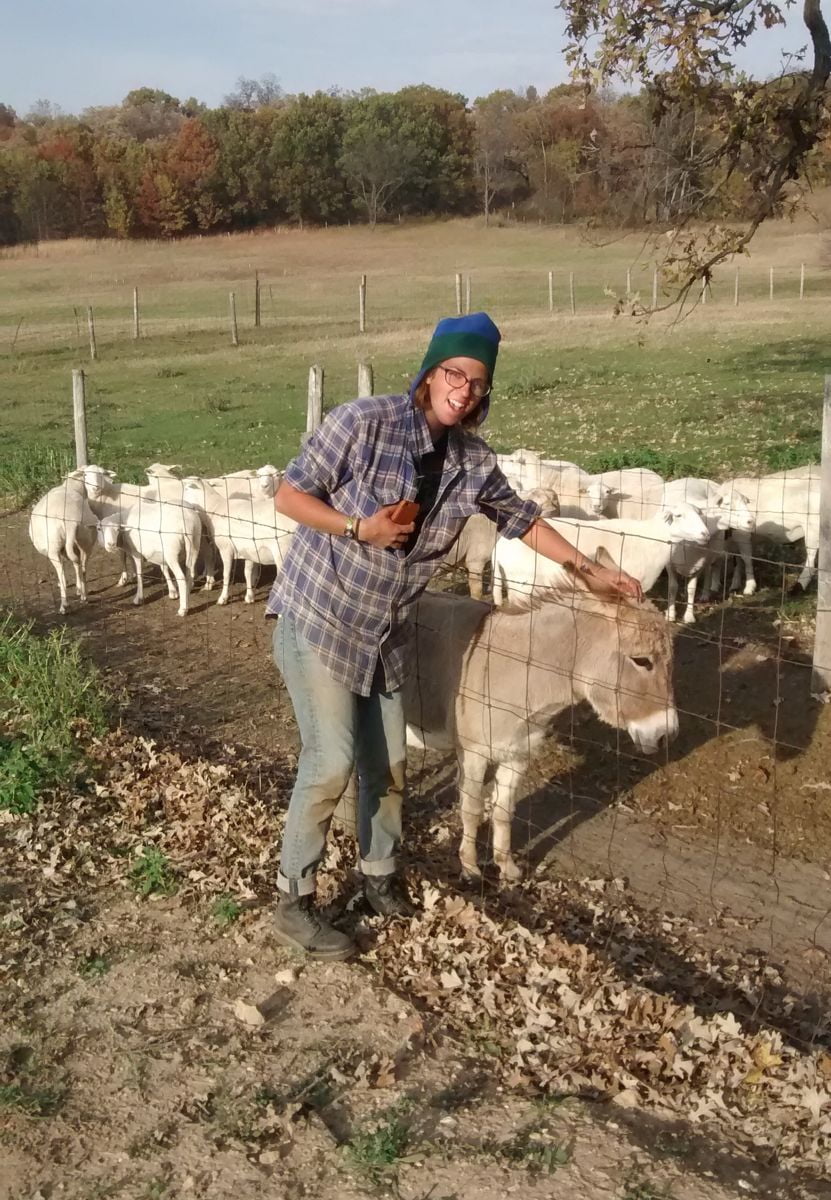
Kelcie and Daisy. Photo by Madeleine.
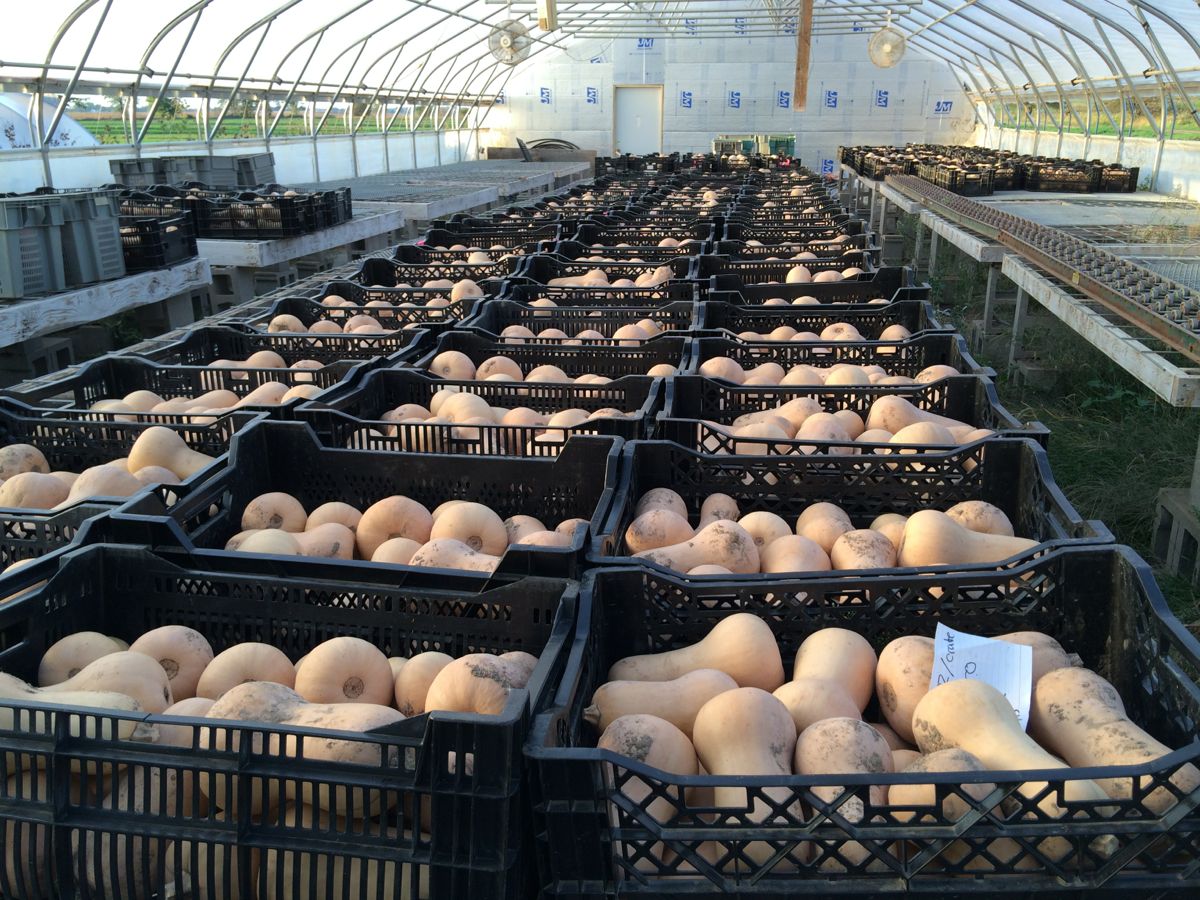
Where oh where could our crates be hiding?
Alien vegetables – Romanesco and colored cauliflower.
Let’s talk about the striking vegetables in your box.
Romanesco broccoli (pale green conical head, possible tinged with purple) – This is the prettiest vegetable we grow. Look at it closely to appreciate its branched beauty and repeating spiral pattern. It is called broccoli, but is closely related to cauliflower which it resembles in flavor and texture. Like broccoli and cauliflower, it is fine eaten raw or cooked. It requires cooking times intermediate between the two. Don’t overcook it. I usually steam it, then dress it simply with a butter-lemon-garlic-mustard sauce.
Purple, white or orange cauliflower – Cauliflower comes in brilliant colors besides white. We planted purple and orange varieties this year, and will rotate the types are they are ready to harvest. Treat the colored types like white cauliflower for cooking. There is a slight flavor difference between white and purple but it is subtle. Purple cauliflower gets its color from anthocyanins, the same compounds that color red cabbage. The color of purple cauliflower fades to blue during cooking. I’ve read that it will stay purple if you acidify the cooking water, but haven’t tried it yet. Orange cauliflower gets its color from beta carotene, which means more vitamin A in your diet.
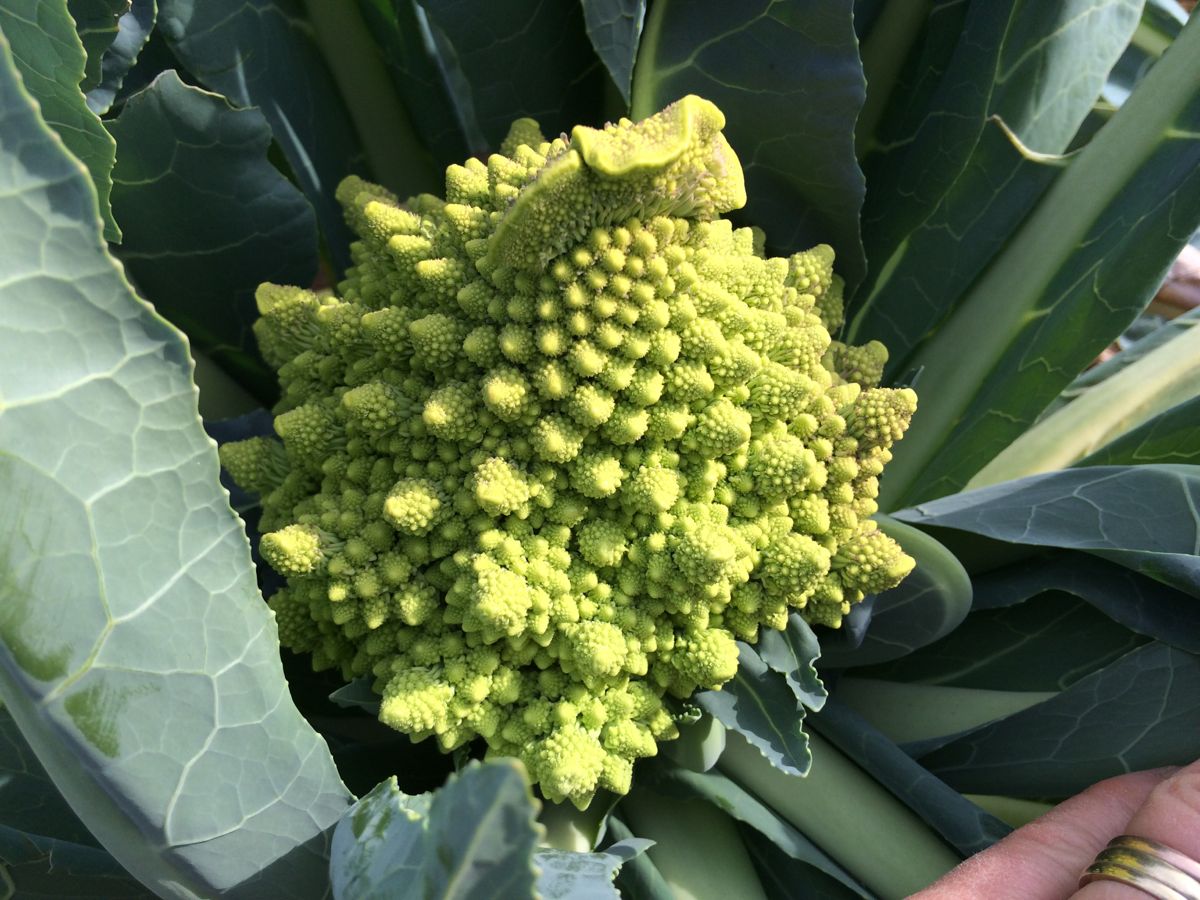
Romanesco broccoli, the prettiest fractal on the farm.
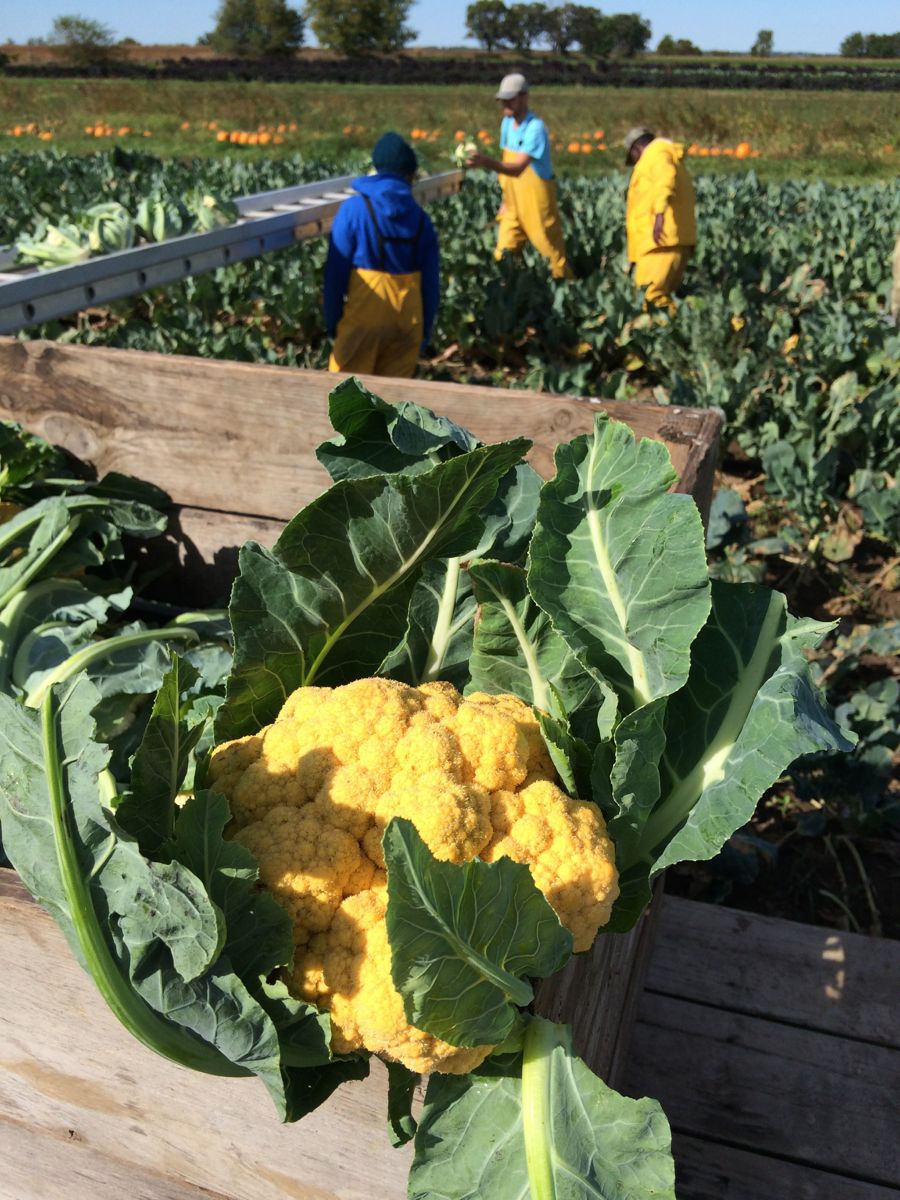
Purple, white and orange cauliflower.
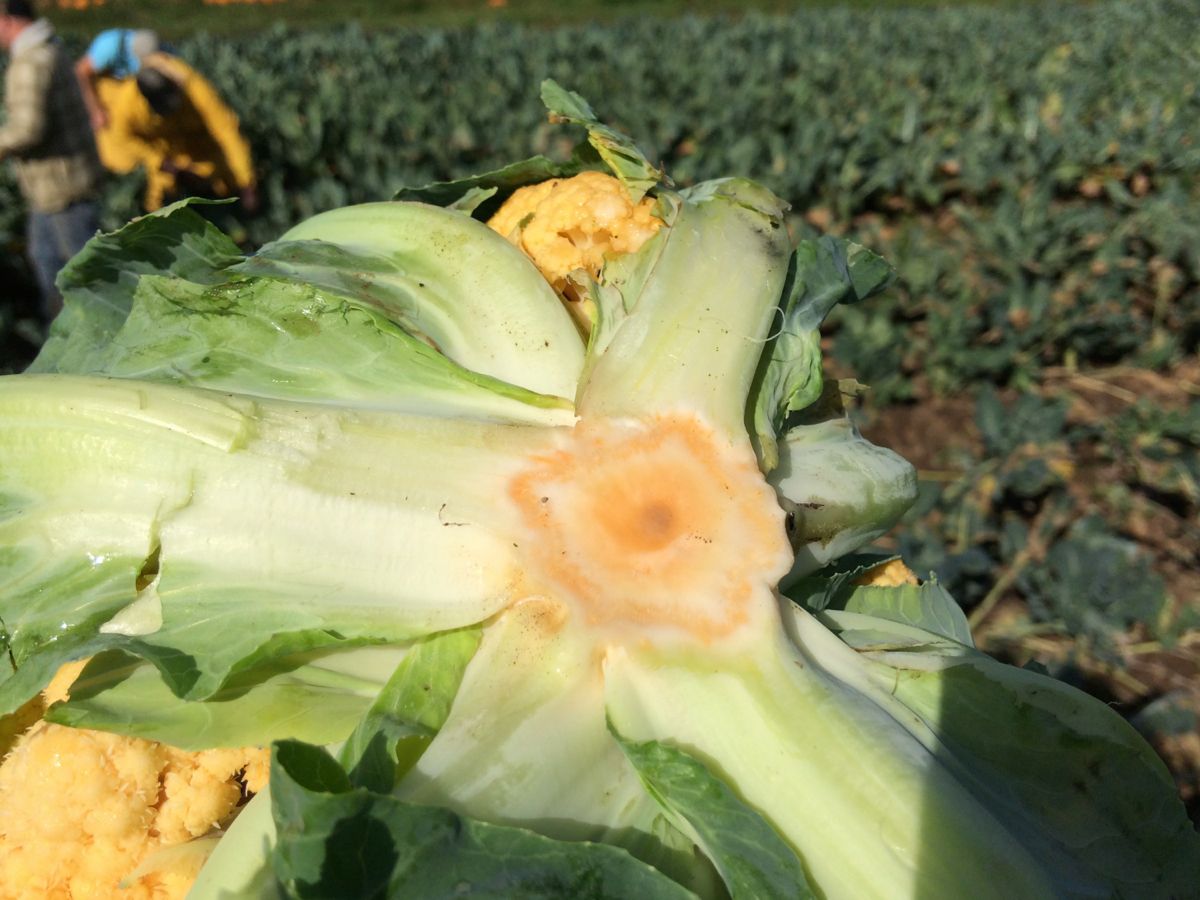
Even the stems of orange cauliflower are permeated with color.
Veggie List and Veggie Notes
Savoy cabbage
Butternut squash
Leeks, 1.5 – 2 lb
Carrots, 2 lb
Frying peppers, about 5
Poblano chiles, 2
Garlic
You’ll receive two of these:
– cauliflower
– Romanesco broccoli
– broccoli
Next week’s box will probably contain cauliflower OR Romanesco broccoli, winter squash OR sweet potatoes, mustard greens, carrots, onions, and more.
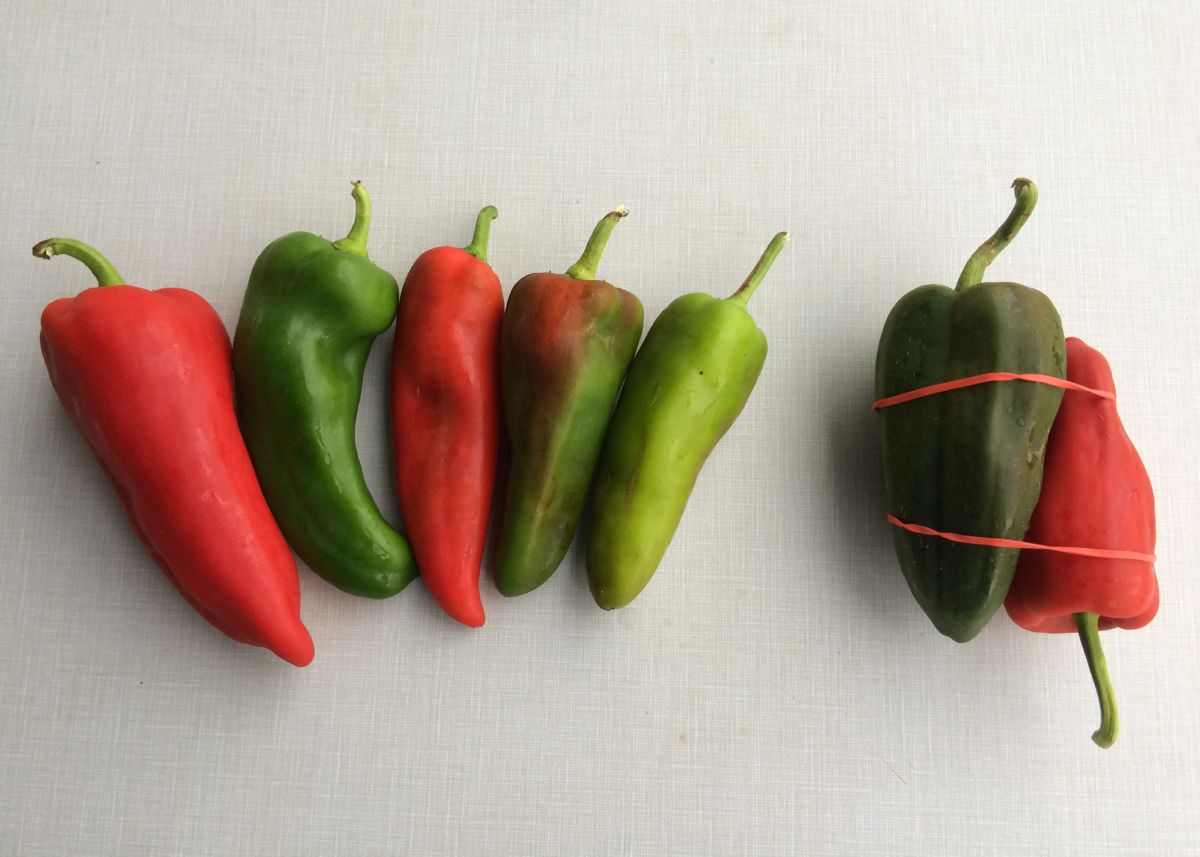
Sweet frying peppers on the left. Mildly spicy poblanos in bondage on the right. We avoid sending similar-looking peppers together when some are hot, some are sweet. It’s the end of pepper season, and our options have dwindled. Respect the rubber bands if you want to keep the types separate.
Frying peppers (long, slender, green or red) – These are sweet.
Poblano chiles (triangular, shiny, green or red) – These are mildly hot. Poblanos are the creme de la creme of chiles. They have lots of great flavor in combination with manageable heat. Steve protected these plants from frost so we would have the chiles for you. Roast and add to soup or casseroles. For our household, they are emblematic of fall cooking.
Savoy cabbage (round green cabbage with pretty, crinkled leaves) – Savoy cabbage can be handled and cooked the same as green cabbage.
Butternut squash – This is our “Metro” variety, a favorite because it cures and sweetens quickly after harvest. These are medium-sized squash, average weight <2.0 lb.
Tip for cutting winter squash
If you want to peel or dice your butternut squash, microwave the intact squash on high for one minute. That’s enough to warm and soften the squash, making it much easier to peel. I find this trick useful even when just cutting the butternut in half.
THIS WEEK’S RECIPES
Comforting Classics
Pulled Pork Sandwich with Sauteed Savoy Cabbage
Squash Cabbage and Tofu Thai Curry with Glass Noodles
Carrot Leek Soup
Parmesan Roasted Romanesco
Mashed Cauliflower
Salisbury Steak with Pepper and Mushroom Gravy
Outside the Box Recipes
Oven Braised Savoy Cabbage
Butternut and Poblano Quesadillas
Creamy Braised Leeks
Steamed Romanesco with Mustard Butter
Cauliflower Latkes
Muhammara
Kitchen Sink Recipe
Braised Chickpeas with Butternut Squash and Cabbage
Quick and Easy Meal Idea
Sweet season
- On: October 14, 2015
 0
0
Fall weather does not get better than this. Our farm work is so pleasant when the weather is sunny and mild. Prepping parsley bunches when it’s sunny and 65oF? That’s perfect – our fingers are ungloved and nimble, we can handle rubber bands. Try tackling that job when it’s 35oF and raining and you are dressed in bulky layers. We know frost is coming soon, but we are trying to extract as much pleasure as we can from these last warm days. The sweet potatoes and winter squash are all harvested (yeah!), and we’ve begun harvesting cabbage for winter storage. These are satisfying milestones. Here are photos from the last few weeks. Beth
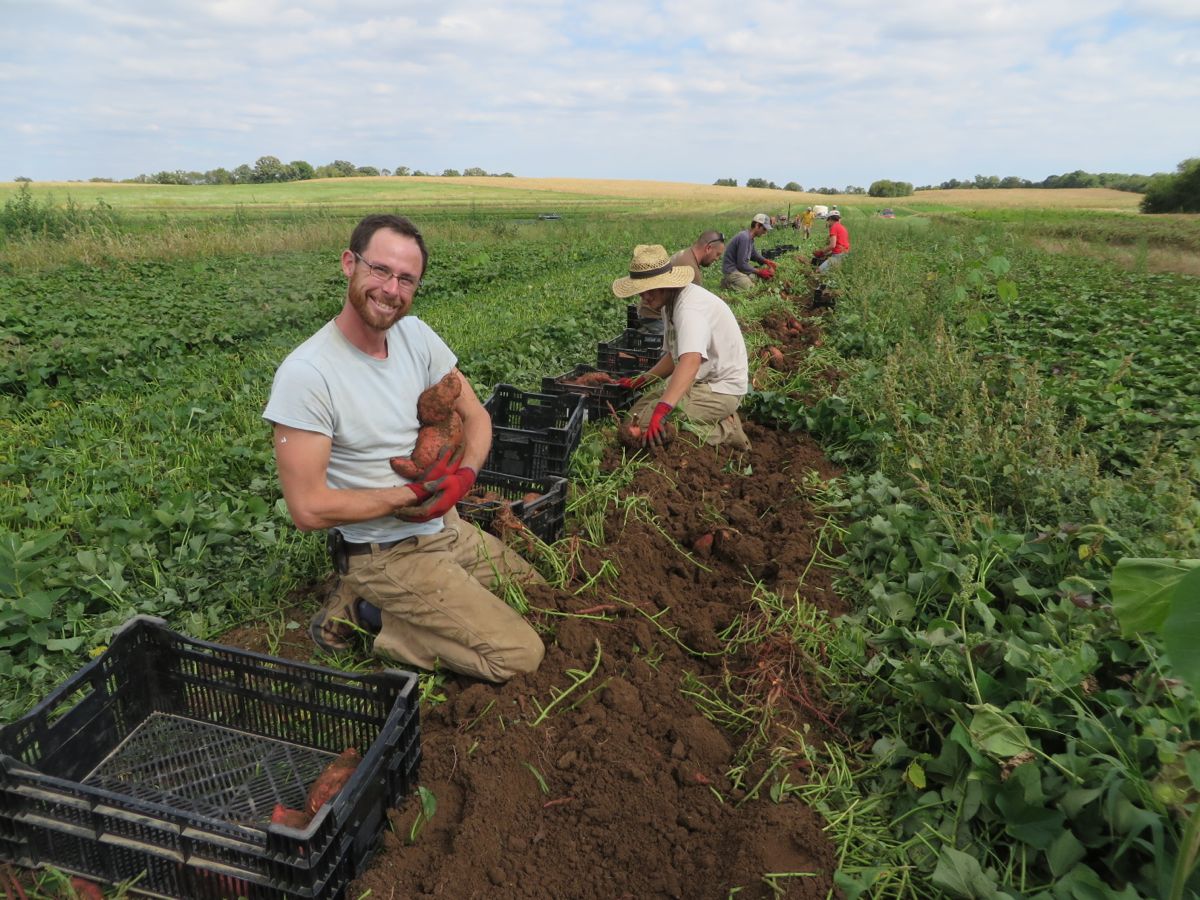
Sweet potatoes pop out of the ground when the soil is just right – not too dry, not too wet. From top, Steve mows the vines and undercuts the roots to bring them to the surface. We pick them up by hand. They need to be handled very gently at this stage. At bottom, Jeremy finds a favorite.
Maggie and team sort winter squash as it comes up the conveyor belt.
Winter squash primer
We will pack several types of winter squash this week, although each member will receive just one type. We tried a few new varieties this year, and are sharing ones that passed our taste tests. Some new varieties are great but others are duds. We only send the good ones. If you have a strong opinion about the squash you receive this week (good or bad), could you let us know? We’ll keep track of where the varieties are delivered.
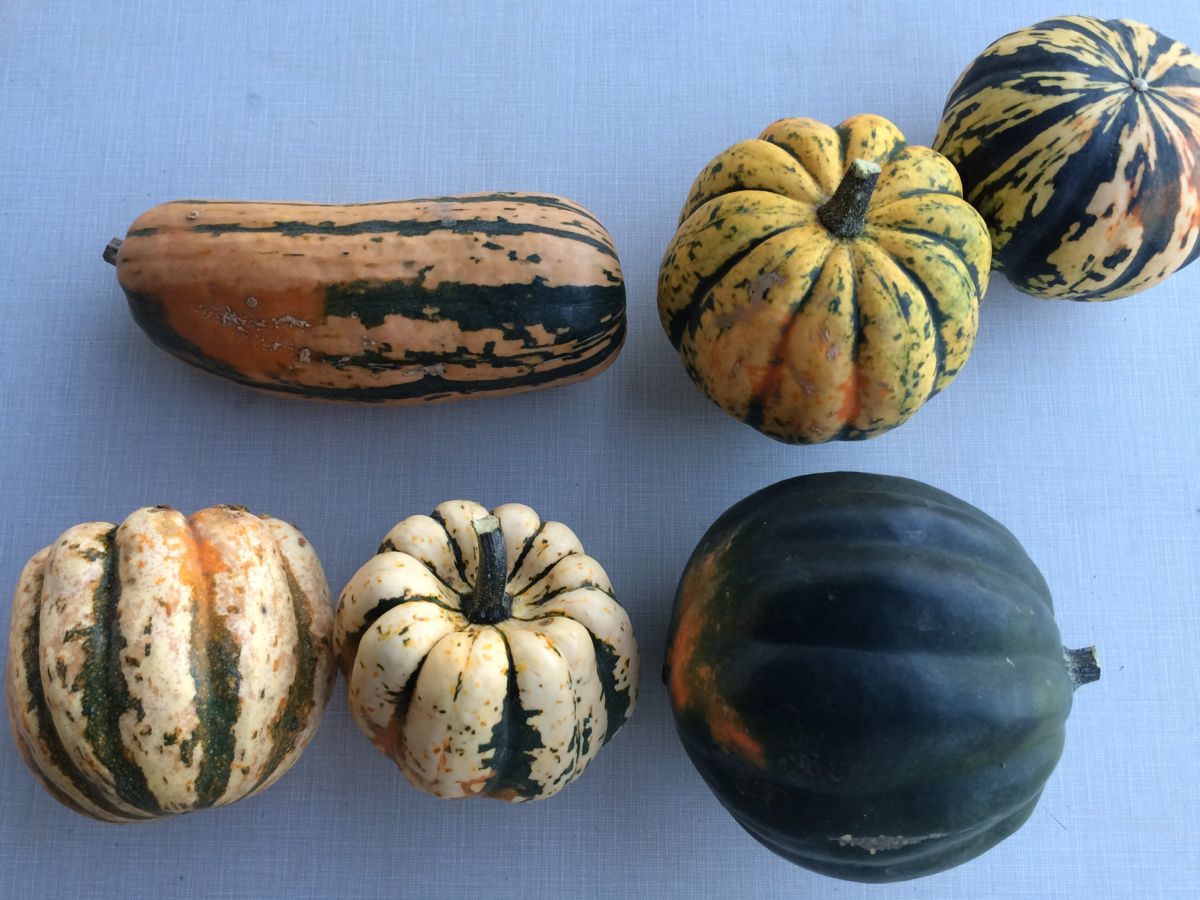
Clockwise from top right, Sugar Dumpling (2), TipTop acorn, sweet dumpling (2), and Honey Boat delicata.
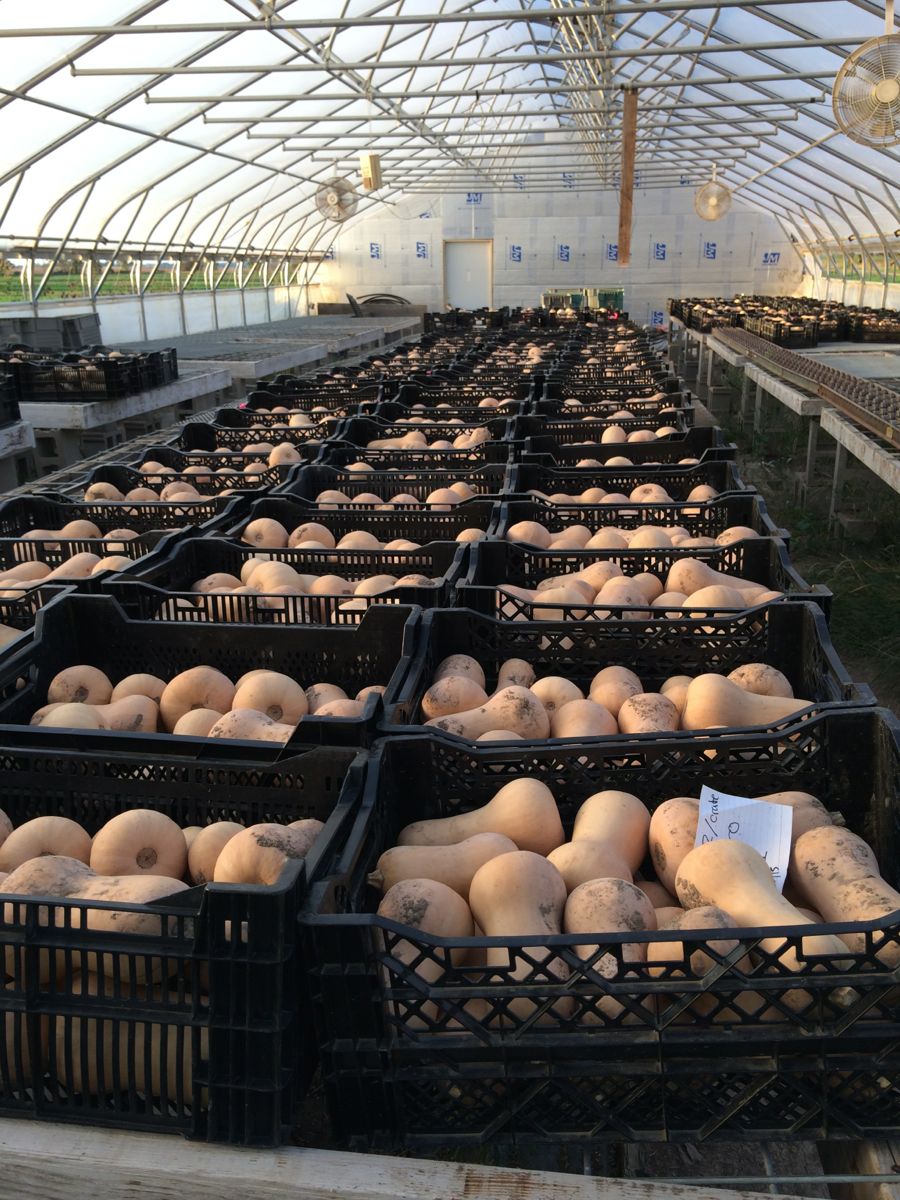
The early winter squashes were not very productive because of pest problems. On the other hand, the butternuts did great. Above, keeping the butternut squash warm and dry in the greenhouse so they cure and sweeten.
Veggie List and Veggie Notes (Oct. 15/16, 2015, week #22, green EOW)
Yellow potatoes, 3 to 3.5 lb
Red beets, 2 lb
Broccoli AND/OR cauliflower
Frying peppers, mixed colors, ~4
Bell AND/OR Oranos peppers
Zavory “mild” habaneros, small handful
Yellow onions, about 2
Scallions, 1 bunch
Parsley, 1 bunch
Winter squash; acorn OR sweet dumpling OR Sugar Dumpling OR delicata
Next week’s box will probably contain cauliflower OR Romanesco broccoli, winter squash, cabbage, leeks, carrots and more.
Peppers! – It’s a pepper medley this week. We are stripping the plants in anticipation of frost in a few days. It is so hard to let the pepper season end. We’ll protect a few varieties with floating row cover so we have peppers for you next week.
Frying peppers (red, green or yellow; long & slender) – Don’t confuse these sweet peppers with last week’s HOT anaheim chiles, in you have any left in your fridge. Look at photos in last week’s newsletter to see how similar they appear. This is our biggest delivery of frying peppers so far this year. Frying peppers are my favorite pepper, so let’s share how we cook them at our house:
– The classic use; pan fried with ones and garlic, then used to top sausages.
– Grilled or roasted, then served atop cheesy polenta.
– I keep a few roasted peppers in the fridge, to top pizza or salads, or dress up grilled cheese sandwiches. They are handy to dress up simple pasta dishes.
– Roasted then pureed with grilled or sautéed onions and garlic to make a chunky spread for bread.
Zavory “mild” habanero chiles (small; red, orange or green) – Well, these chiles have gotten hotter than the last time we delivered them. Not sure why. They are still pretty mild, about the same as an Anaheim, with lots of interesting flavor.
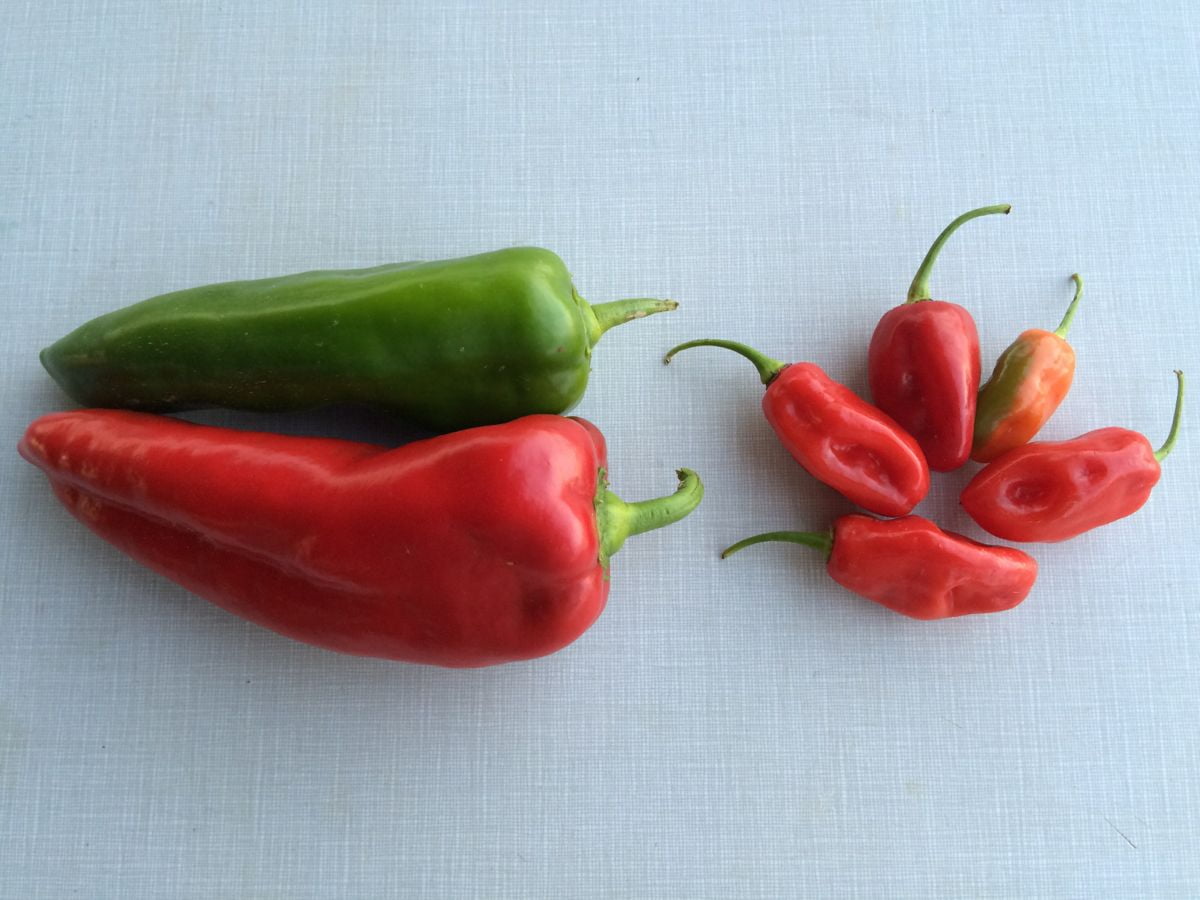
At left, sweet frying peppers. At right, mildly hot Zavory habaneros.
THIS WEEK’S RECIPES
Comforting Classics
Cream of Broccoli Soup
Parmesan Scalloped Potatoes
Russian Beet and Potato Salad
Sweet Italian Pepper Sauce with Capellini
Cauliflower with Olives (works with broccoli too!)
Honey Soy Squash Rings
Outside the Box Recipes
Grilled Marinated Broccoli
Potato Enchiladas
Vegan Beet Chocolate Lava Cakes
Sloppy Joe’s with Pickled Sweet Peppers or Vegan Sloppy Joe
Hot Pepper Hash Browns with Cheddar
Oven Fried Squash Rings
Kitchen Sink Recipe
Moroccan Stewed Vegetables over CousCous
Quick and Easy Meal Idea
U-Pick Wrap-Up
- On: October 07, 2015
 0
0
Steve and I are still coasting on the energy from our pumpkin u-pick this past Sunday. Lots of members wandered the farm to pick pumpkins and glean some extra produce. We’re happy to share. Much of the gleaned produce would be lost to frost in a week or two. Some of you have brought your children to our gleaning party since they were babies. We always hope mucking around during the u-pick will encourage open-mindedness about food in a few more children. Parents told us lots of broccoli and carrots were munched on during the u-pick. For those who are curious, here’s the final list of gleaning crops we offered: carrots, broccoli, tomatoes, tomatillos, Italian beans, kale, jalapeños, cilantro, peppers and raspberries.
I’ve posted photos from the u-pick on our Facebook page, but here are more.

Steve and I enjoy the chance to visit with members. We’ve fed you all season!
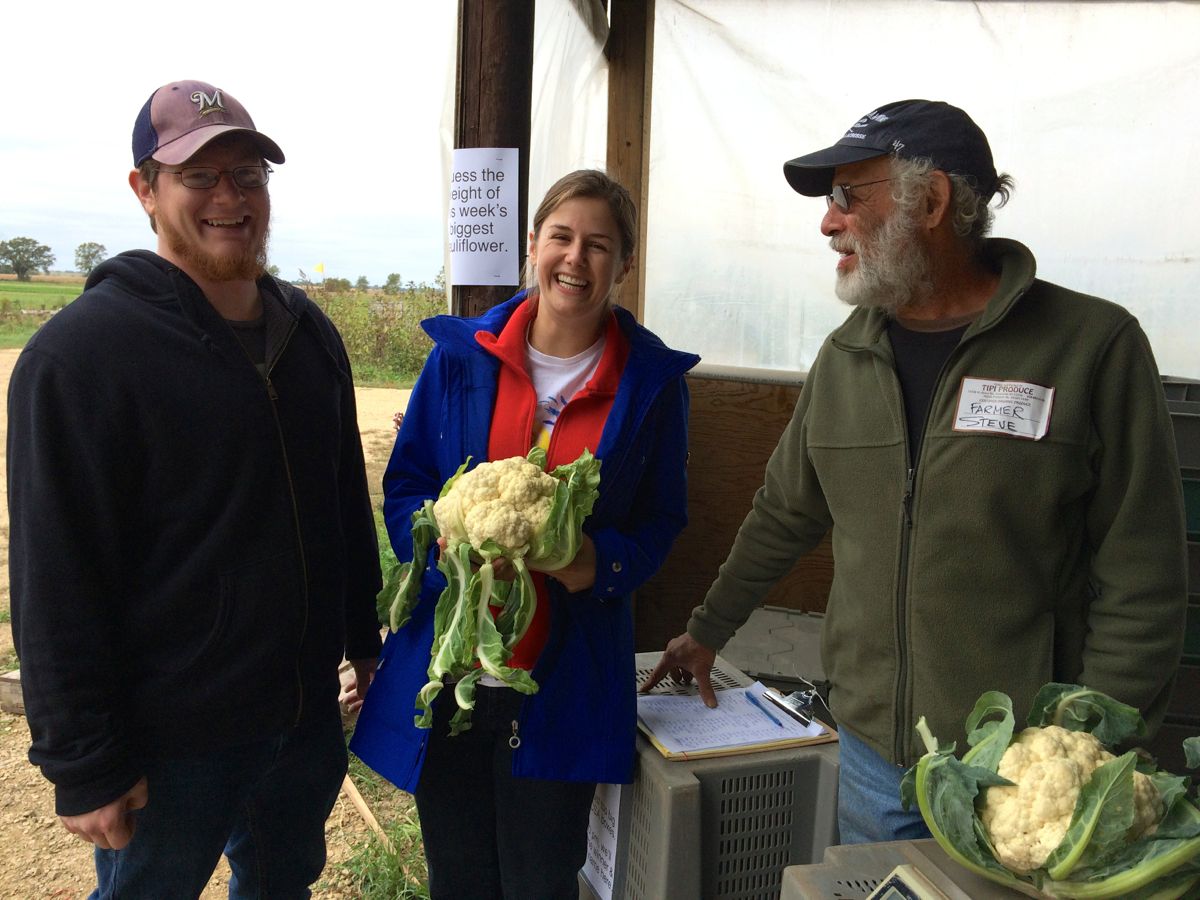

Second runner-up winner in the ‘guess the weight of the giant cauliflower’ contest, with her prize. The giant cauliflower would fit in a CSA box, but there would not be room for anything else.
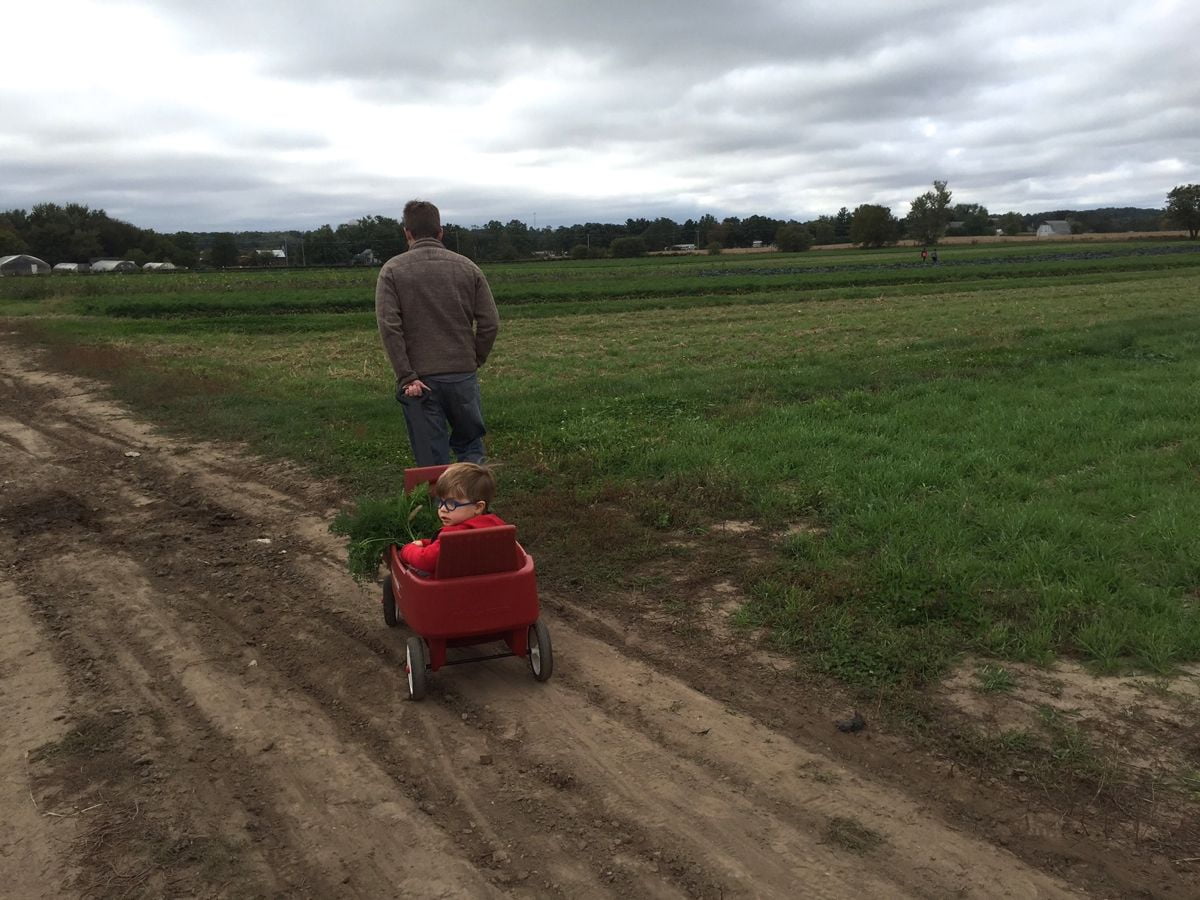
I love this photo because it captures the scale of our farm. First-time gleaners mentioned the unexpected distance they covered while gleaning. The farm feels big when you are on foot. FYI, the grassy planting on the right is a rye-vetch cover crop.

It’s not just pumpkins that are interesting. Thanks Marty for the last two photos!

Julie Garrett found the beauty in our raincoats hung up in the washroom.
Questions that arose during the u-pick.
If one person asked, then others are probably curious too.
What about that tomato u-pick?
We are busted – we promised a tomato u-pick this season but did not pull it off. For a u-pick to work, we need a big surge of tomatoes. We planted two tomato fields (as usual) but the early one did poorly because of the wet spring. The second tomato planting did great, and really carried the load for the CSA boxes. Week after week, we had enough tomatoes for 4 lb per box, but those were all harvested from one field. We had just enough extra tomatoes to bottle tomato juice for next season. Without two fields ripening at once, we never reached a moment when we were sloshing in tomatoes and ready to host a u-pick. Maybe next year?
Are you going to put raspberries in the CSA boxes again?
Nope, our raspberry-production days are over, due to the fruit fly that arrived in Wisconsin a few years ago. We mowed down half our raspberry planting but can’t bear to rip it out completely. That’s where members picked berries this weekend.
Is the CSA season over now that the gleaning party has happened?
No, there are six deliveries to go, including this week. See below for the final delivery dates.
A member asked if this is the first time the gleaning party happened before frost.
He remembered many years when frost came a day or two before the gleaning party, and how much it affected the tomatoes he tried to glean. That’s pretty accurate. We time the u-pick for near the average first frost date for this area, October 8. If we host it too early, we won’t be ready to offer crops for gleaning. If we wait too late, most of the gleaning crops will be badly damaged.
Six boxes yet to pack
November 5/6 = final delivery for purple EOW members
November 12/13 = final delivery for weekly members and green EOW members.
Veggie List and Veggie Notes (October 8/9, 2015, week #21, purple EOW)
Sweet potatoes, about 2+ lb
Broccoli, 1 head, some are small
Red kale, 1 bunch
Carrots, 2 lb
Bell peppers, red or green, about 3
Yellow onions, about 2
Fennel, 1 head with fronds
(You might not get fennel if your cauliflower is big.)
Cauliflower OR globe eggplant OR Japanese eggplant
Anaheim chiles, HOT, 2 – 3
Scallions, 1 bunch
Baby ginger, 1 chunk
Garlic, 1 head
Next week’s box will probably contain potatoes, peppers, winter squash, broccoli or cauliflower, and more.
Sweet potatoes – Some of these are BIG. The early samples we dug seemed so modest in size. At harvest, we found they had grown quite a lot. Don’t worry, quality is fine for the big ones. Just don’t try to roast them whole. It will take a long, long time. Big ones, small ones, all are excellent cut into pieces, oiled, and roasted at 425oF , e.g. as sweet potato fries.
Anaheim chiles (long slender peppers, red or green) – These are HOT peppers. Anaheims usually have medium spiciness although it varies from pepper to pepper. As usual, the heat is concentrated in the seeds and midveins. Remove the seeds and midveins is to lessen the chili’s heat. Anaheims are easily mistaken for Italian frying peppers. We never send them in the same box for that reason. Keep this in mind if you have peppers left over from previous weeks.
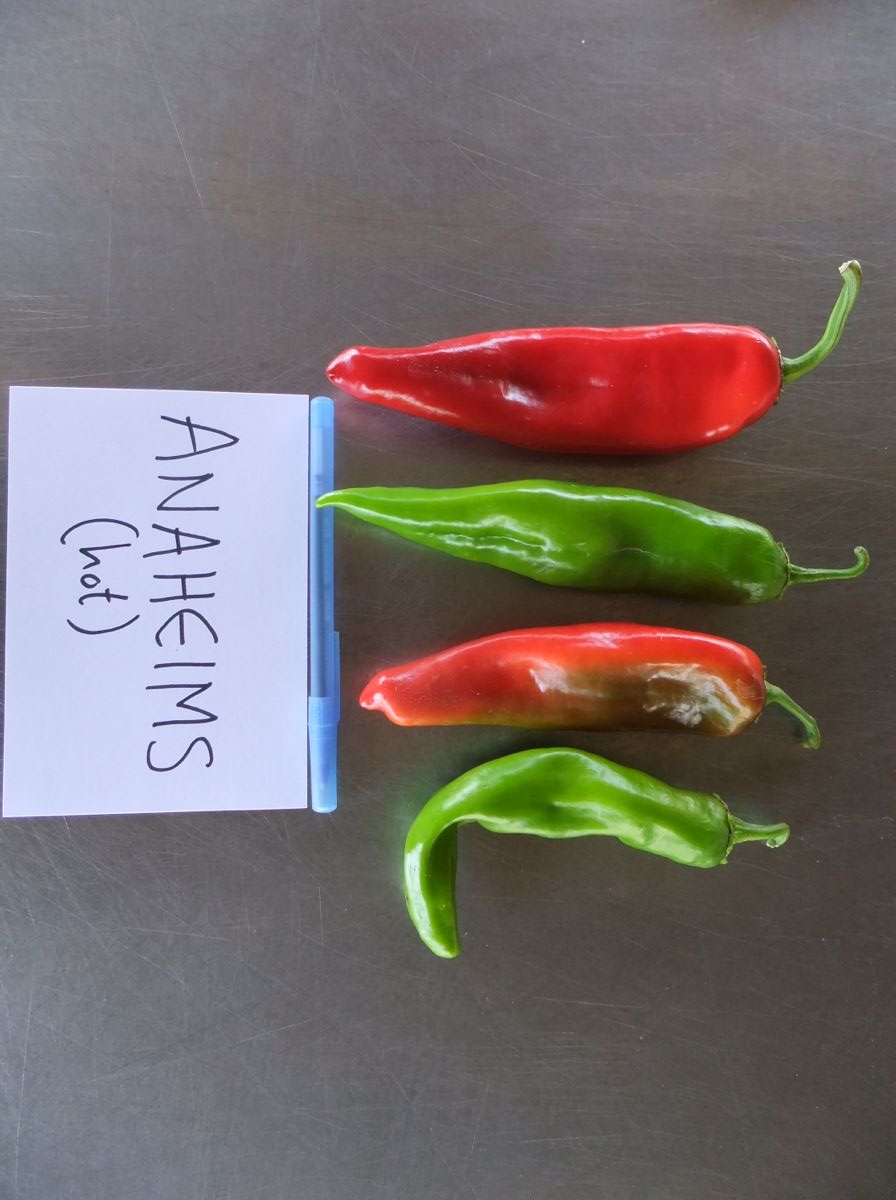
See how much this week’s HOT anaheim chiles (above) resemble last week’s SWEET frying peppers (below)? Keep them separate if you still have peppers leftover from last week.
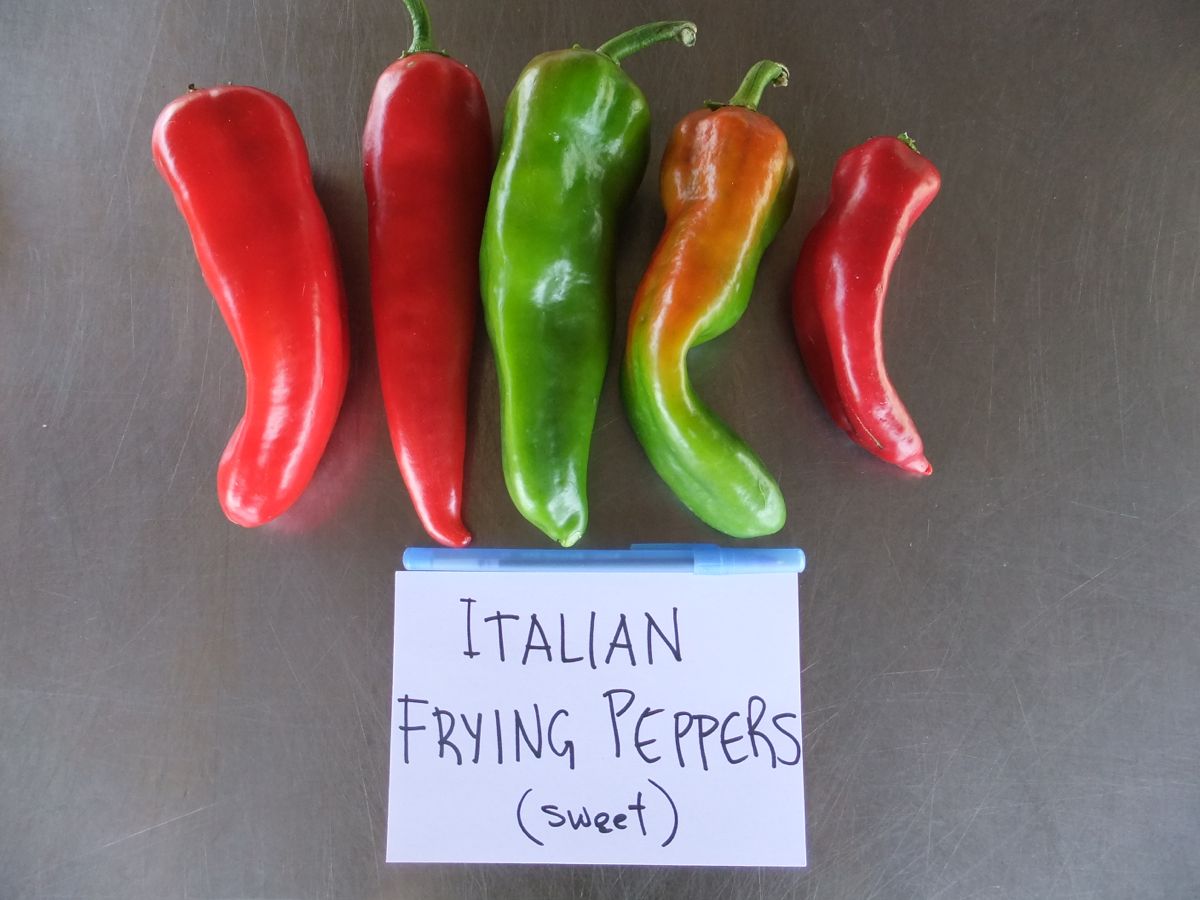
THIS WEEK’S RECIPES
Comforting Classics
Crunchy Broccoli and Carrot Salad
Kale with Smoked Paprika
Roasted Sweet Potatoes with Hot Sauce
Caramelized Fennel
Stir Fried Eggplant with Tofu and Peppers
Curried Cauliflower
Outside the Box Recipes
Broccoli Latholemono
Sweet Potato Kale Hash
Chai Scented Sweet Potatoes
Fennel and Sausage Risotto
Spiced Peppers and Eggplant
Cauliflower and Fennel Vegan Bisque
Kitchen Sink Recipe
Sweet Potato Shepherd’s Pie with Carrots and Broccoli or with Lentils
Quick and Easy Meal Idea
Ginger harvest
- On: October 01, 2015
 0
0
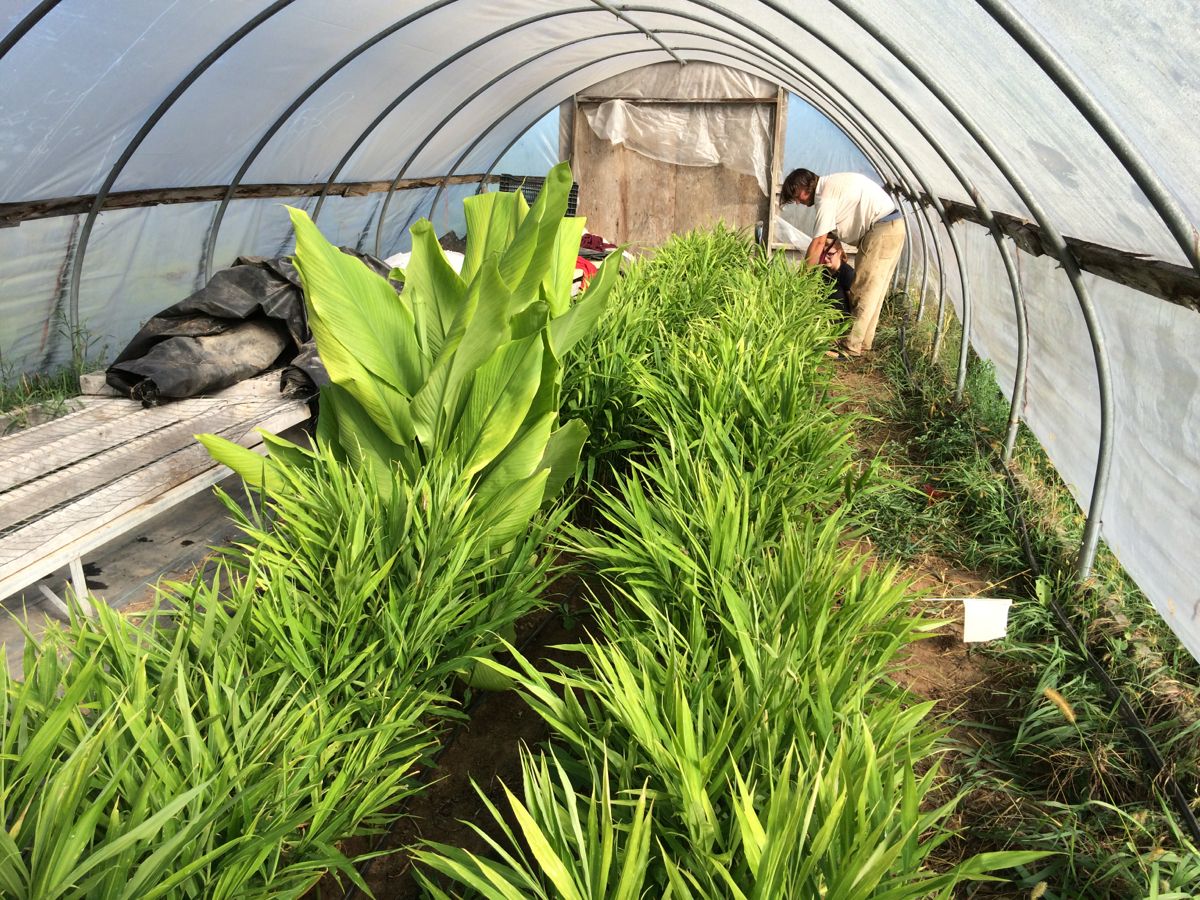
We harvested half our ginger this week. It’s time – nights are chilly inside the greenhouse, and we don’t want the tropical ginger to get damaged by cold. I have loved this small planting. It feels garden-like on this scale, at least in contrast with our vegetable fields. It’s always interesting to grow something new and unusual. Above, Jory digs the ginger from the ground. Aren’t the plants lush? Most of what you see are ginger but the taller plants on the left are turmeric. We planted a few seedlings for fun and were surprised at how big they grew.
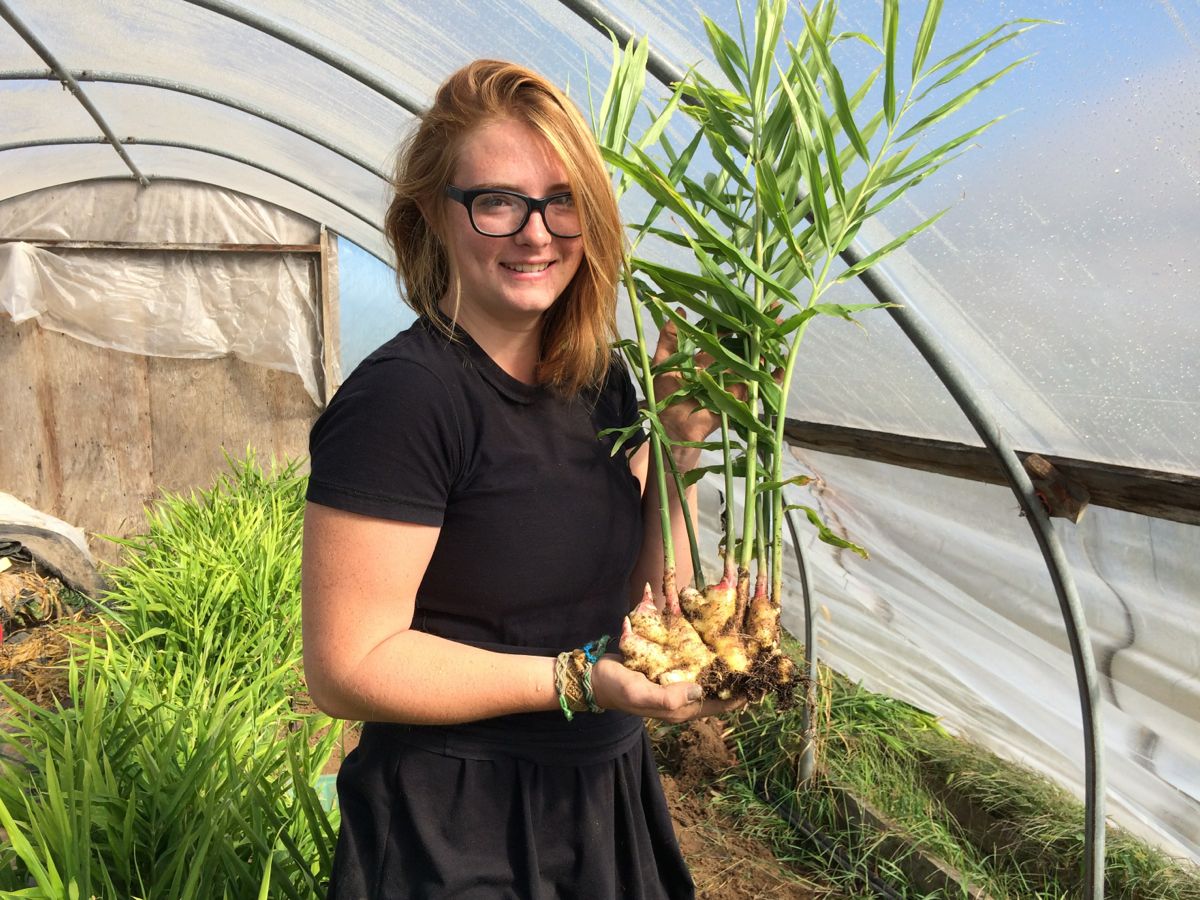
Caitlin’s job was to grade and trim the ginger root.
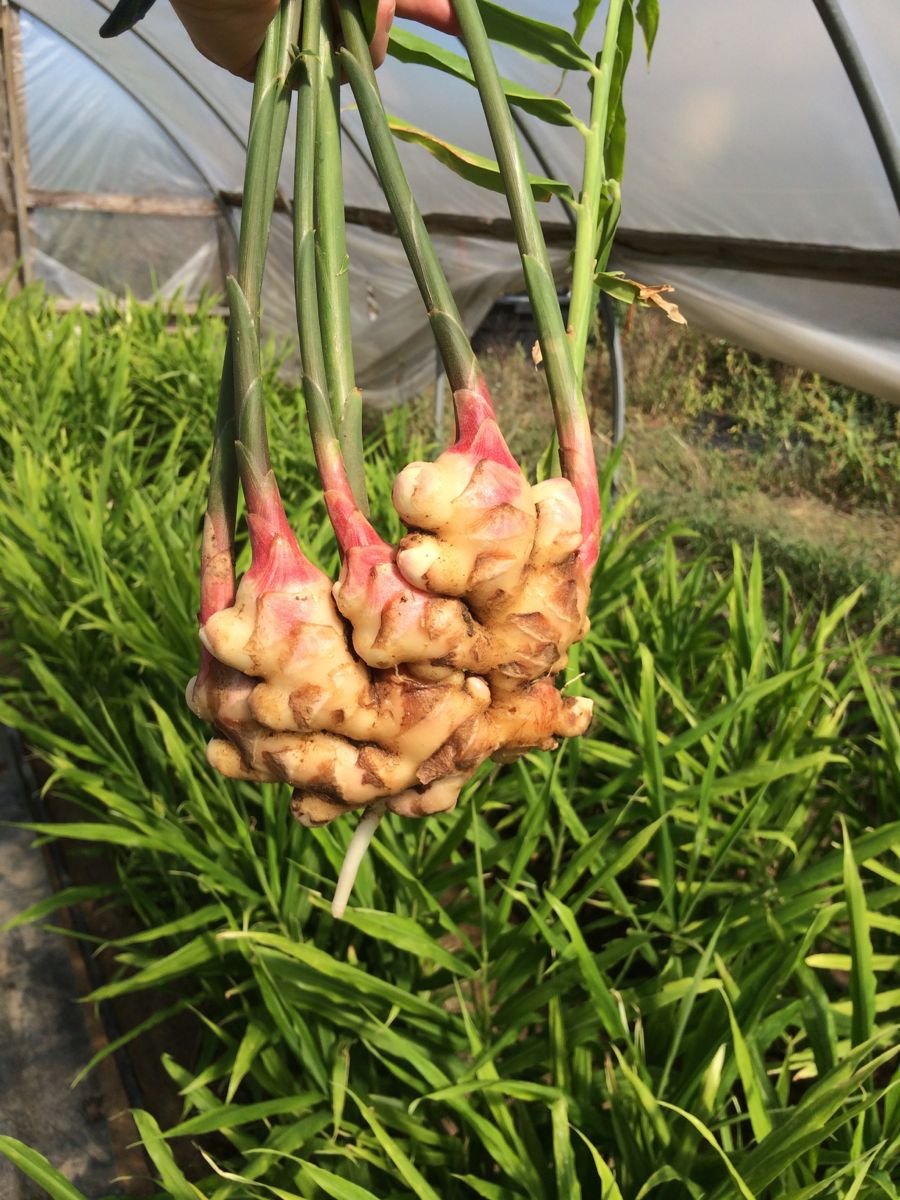
This is baby ginger, bright white and pink because it hasn’t grown a brown epidermis yet. It takes a long season to grow into the mature ginger you find in stores. It’s usually grown in warm places like Hawaii. Baby ginger is special because it has the full ginger flavor and spiciness but almost no fibers. That’s why it’s used to make the pickled ginger served with sushi.
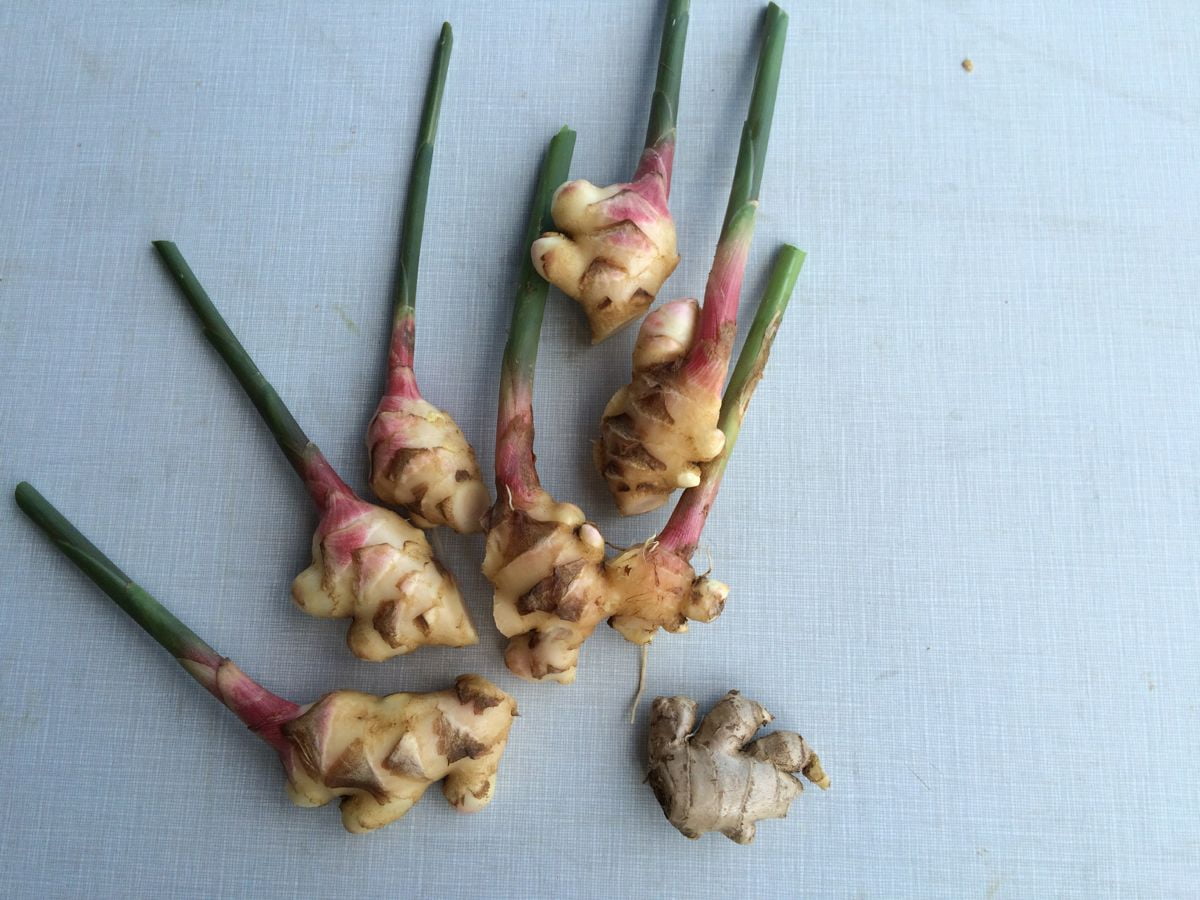
We cut the roots into plump pieces to distribute in this week’s CSA boxes. We’ll harvest the remaining ginger next week, so the purple EOW members get to try some too. See the brown piece at bottom right? That’s the seed piece we originally planted in spring.
Storage Shares
We have just a handful of storage shares left. Sign up by the end of this weekend if you are still interested. You can read here about what we delivered in last year’s storage share.
Current Tipi members, sign up here.
New members, sign up here.
Please scratch your name off the checkoff list every week.
One of our site hosts called last week to tell me there was one unclaimed box at her site, but six names still on the list. She didn’t bother making reminder calls that week. Please scratch your name off the checkoff list. Please take care of it before you take your box – your hands are empty and you are less likely to get distracted by your beautiful produce.
Veggie List and Veggie Notes (October 1/2, 2015, week #20, green EOW)
Red bok choy OR Yukina
Edamame soybeans, 1 bundle
Carrots, 2 lb
Broccoli OR cauliflower
Italian beans, 1 lb
Frying peppers, 3
Oranos peppers, 2 – 3
Tomatoes, 1 to 3
Yellow onions, about 2
Jalapeño chiles, 2
Basil, 1 husky sprig
Baby ginger, 1 knob
Next week’s box will probably contain carrots, onions, peppers, ginger and much more.
Some sites will get red bok choy, some will get Yukina. These related vegetables are similar, although Yukina is larger and more strongly flavored. They can be used interchangeably in recipes.
Red bok choy (loose rosette with thick stems and magenta leaves) – This Asian green is good for stir-frying or sautéing or in soup. It’s also good as a raw, marinated salad, like a fresh unfermented kimchi. You can think of the stems and leaves as two separate vegetables. The stems require longer cooking. The leaves will cook almost as quickly as spinach. Refrigerate in a plastic bag.
Yukina (large heads of dark green leaves) – This is my favorite fall green. It is nutritious, delicious, a great combination of mustard-like leaves with crunchy stems. These yukina look big, but will shrink once cooked. We usually steam and drain chopped yukina, then dress it with a cooked mixture of fried garlic and ginger simmered with olive oil, balsamic vinegar, soy sauce, a little sugar and a lot of paprika or hot pepper flakes.
Edamame (bundle of stems with pods attached) – See our notes from three weeks ago about how to cook.
Carrots – The first fall carrots!
Italian beans – The last summer beans! Really, that’s the end. We added an extra bean planting this year, for a total of seven deliveries. We hope you enjoyed them. These Italian beans are mature enough that they will be best braised. Pat came up with a nice braised chicken and Italian bean dish for us.
Tomatoes – Well, tomato season is ending. It’s so hard to let go. Enjoy these last few tomatoes we picked for you this week.
Jalapeño chiles (small green chiles) – These are HOT. Handle with caution. Remove the seeds and midveins to lessen their heat.
Baby ginger – See above. Wrap in a damp cloth or paper towel, and keep in the refrigerator in a plastic bag. Eat soon; baby ginger is perishable and we plan to send more next week. This stuff bruises easily so we gave it just a light washing, and figured you could do the fine washing when you cut it up.
THIS WEEK’S RECIPES
Comforting Classics
Chilled Lemon Marinated Cauliflower
Cheesy, Creamy Brown Rice, Broccoli and Greens Casserole
Braised Chicken with Romano Beans
Sesame Salad with Bok Choy or Yukina
Slow Braised Goulash
Ginger Curried Carrot Soup
Outside the Box Recipes
Cauliflower Gallette Crust
Broccoli Hummus
Yukina Savoy with Sweet Chili Sauce
Braised Sausage, Pepper, Onion and Scrambled Egg Sandwich
Japanese Carrot Ginger Dressing
Kitchen Sink Recipe
Roasted Fall Vegetable Quinoa Salad
Quick and Easy Meal Idea
Last chance for storage share + Willy Street parade
- On: September 23, 2015
 0
0
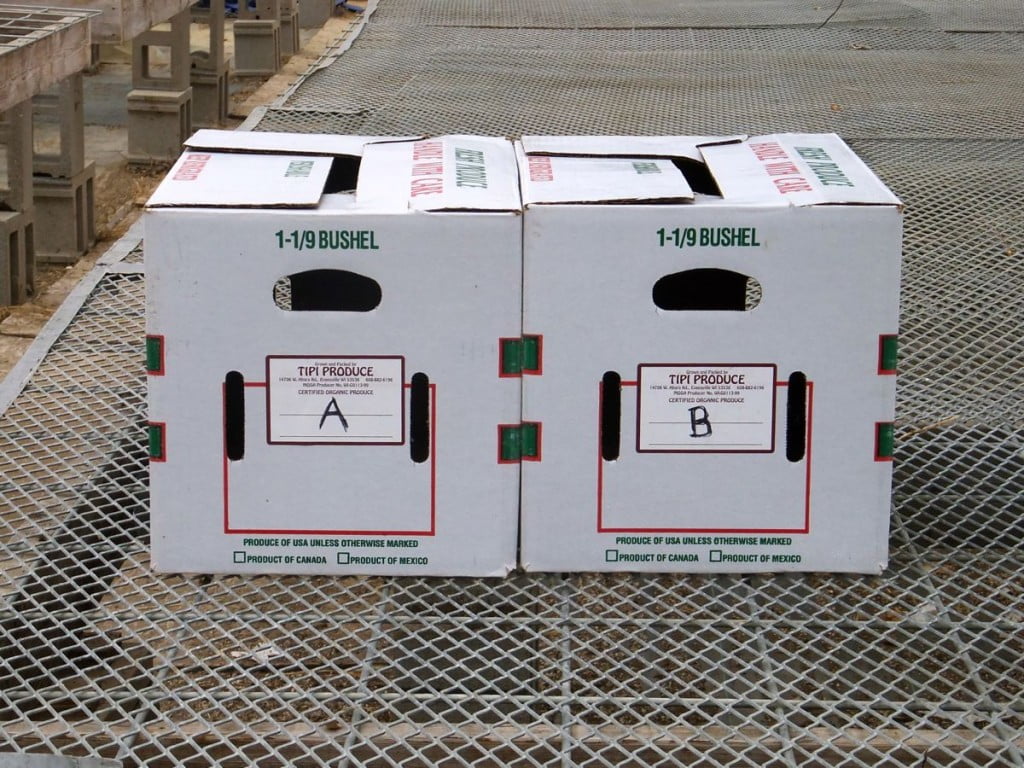
Storage share = two large boxes in November.
We still have a few storage shares available for hungry members who want to extend their CSA season. Our storage share consists of one delivery of two large boxes. Delivery date will be November 19/20, 2015 (Thurs/Fri sites). This is the last chance to sign up – we need to place our potato order soon.
To register for a winter share, go to tipiproduce.csasignup.com/members/updatemembership and follow the instructions.
Cost: The cost is $105.
Payment: Register online, then send a check for $105 to Tipi Produce, 14706 W. Ahara Road, Evansville, WI 53536
Deadlines:
– The deadline to register is September 30, or when the shares sell out.
– To hold your reserved storage share, we need your payment in hand one week after you register, and no later than Oct. 6.
The produce: This delivery is much larger than deliveries during the CSA season, about 3 times the size of our typical CSA box, packed into two large boxes. The contents will depend on the weather, and what is available and good quality. Expected contents include potatoes, carrots and onions, plus stored crops such as winter squash, leeks, garlic, cabbage, beets, celeriac, parsnips, rutabagas and winter radishes. We will probably include something fresh from the garden, eg. Brussels sprouts, cauliflower, broccoli or greens. Some veggies will need to be refrigerated. Others can be stored at room temperature. Click to see what we delivered in the 2014 storage share.
Not sure if you already ordered a winter share? Send yourself an email with your membership info at tipiproduce.csasignup.com/members/statusemail. Once the email arrives, look under Membership Details/ Member Type 1 to view whether you have already signed up for a winter share.
Willy Street Fair
Our crew gathered to march in the Willy Street Fair parade again this year, powered by Maggie and Jon’s energy. Actually, everyone was pretty enthusiastic. This year’s innovation? Maggie screen-printed sixty “Water On” Tipi t-shirts to give away. This is the special shirt she designed for our farm crew. That woman has so much energy. Jon constructed a catapult from a giant rubber band and a u-boat, a type of cart. That meant we didn’t just toss the t-shirts into the crowd, we launched them. Orange Orano peppers, grape tomatoes and flowers were our other offerings. Our friend Rob Summerbell of Jolly Giants Entertainment followed us in the parade, steering his enormous Wacky Wheeler. “Look at that,” he thought, “everyone is eating orange popsicles.” Nope, those were our orange peppers. Some people take them, some people don’t. I guess peppers and tomatoes are unexpected parade treats.
We were positioned just behind the bubble mobile, a pearlescent place to be. Check out the boys’ outfits. They planned them for weeks. We were glad to hear many shouts of “Hey! That’s my CSA.”
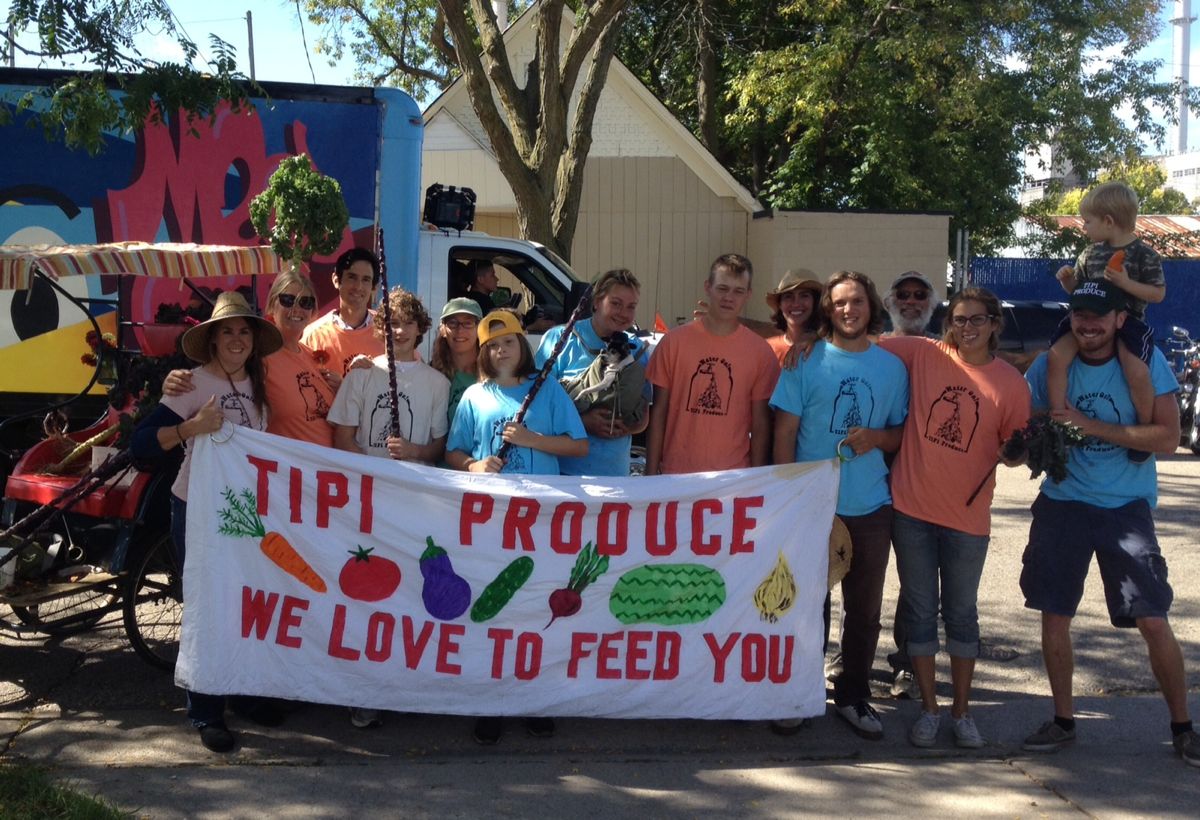
Maggie made the banner last year. The handles are rims for canning jars!

From back, Lizzy (with kale), Kelcie, Jory, Madeleine with Pickles in pouch.

The bubble-mobile. We were honored to trail the parade’s biggest celebrity.


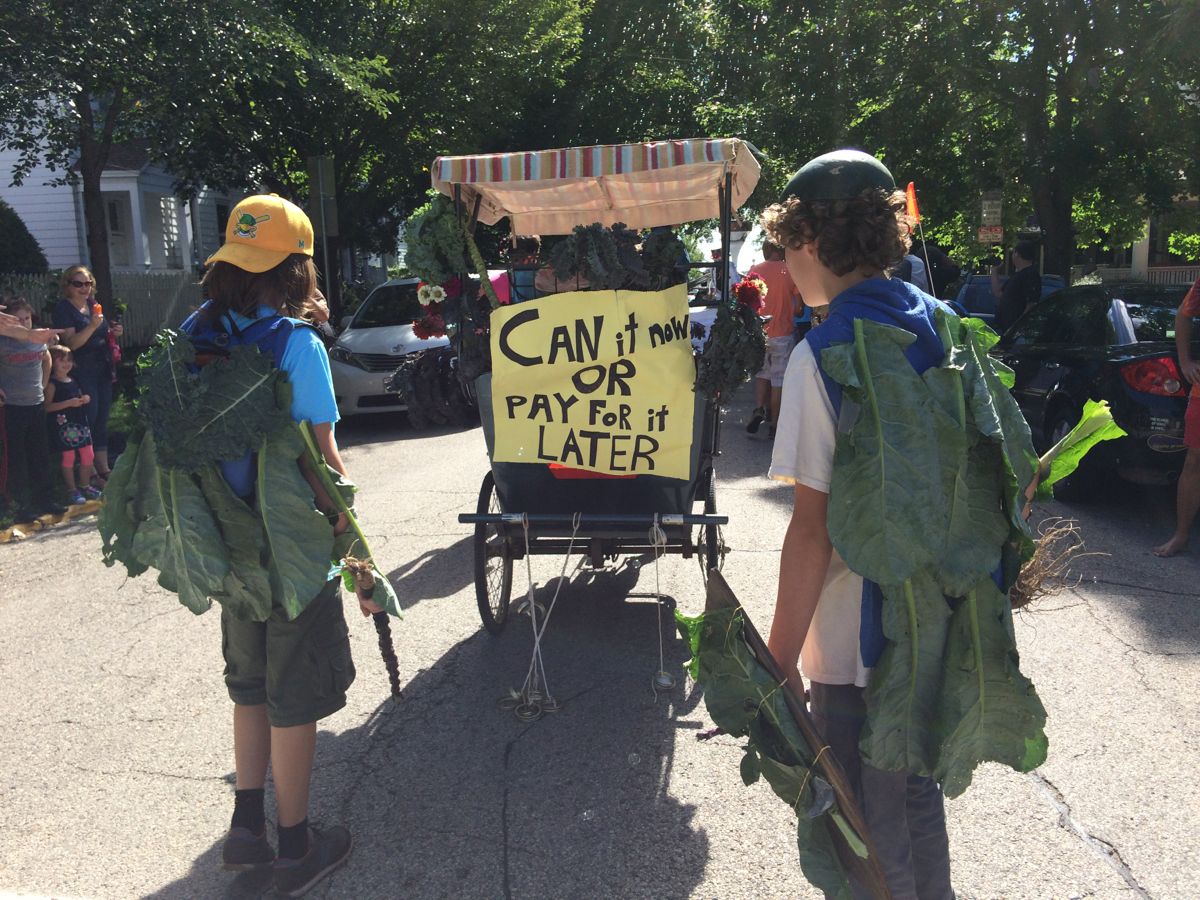
Melon Man and Brassica Boy, armed with kale sabers. They made their capes from cauliflower leaves, the sturdiest leaves on the farm right now. See the noisemakers trailing Maggie’s rickshaw? More canning jar rims.

Jon (carrying kale), Steve and Jeremy bring a u-boat loaded with peppers and tomatoes. The thick rubber band nearest the top is our t-shirt catapult.

Our tallest fan enjoys a grape tomato.
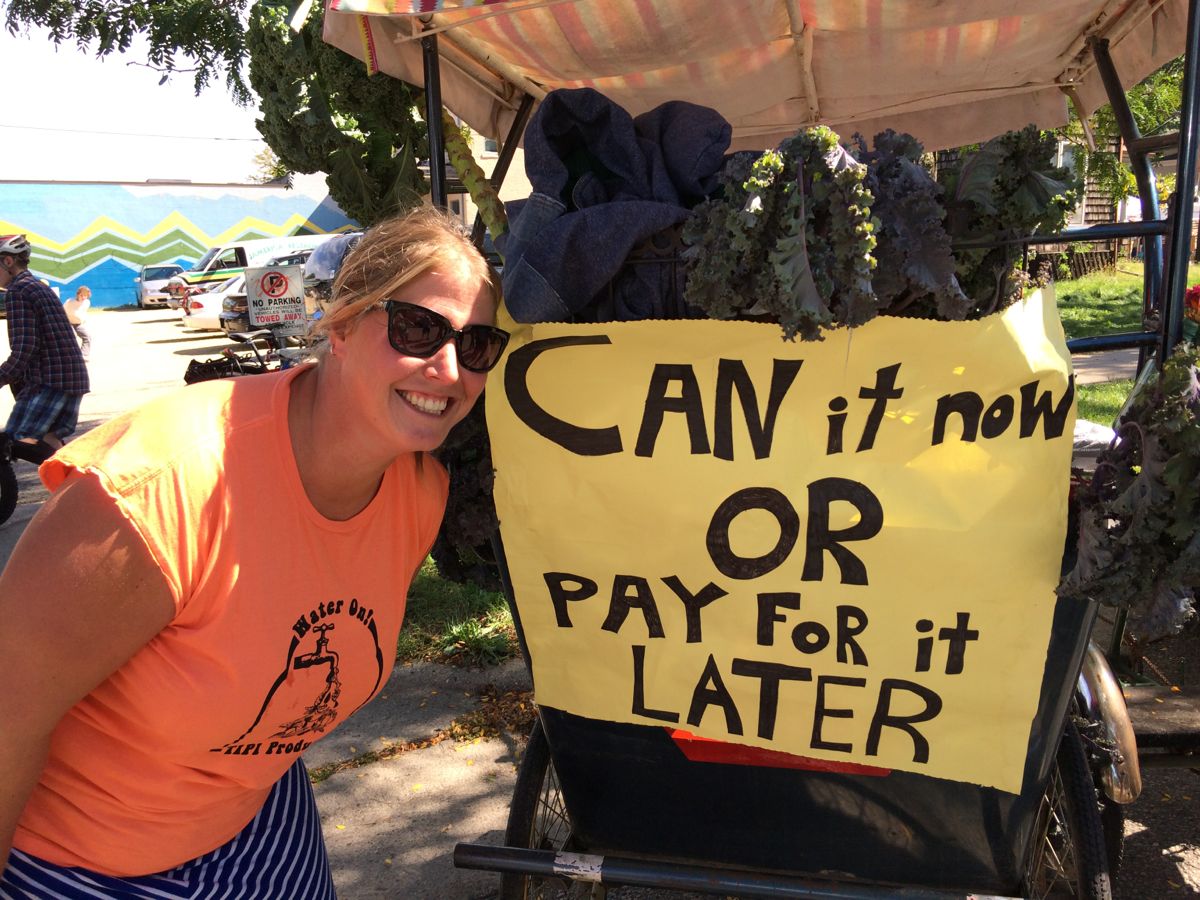
Maggie with her rickshaw. Someday soon, I will write about the crew’s efforts preserving produce for winter. They are heroic.
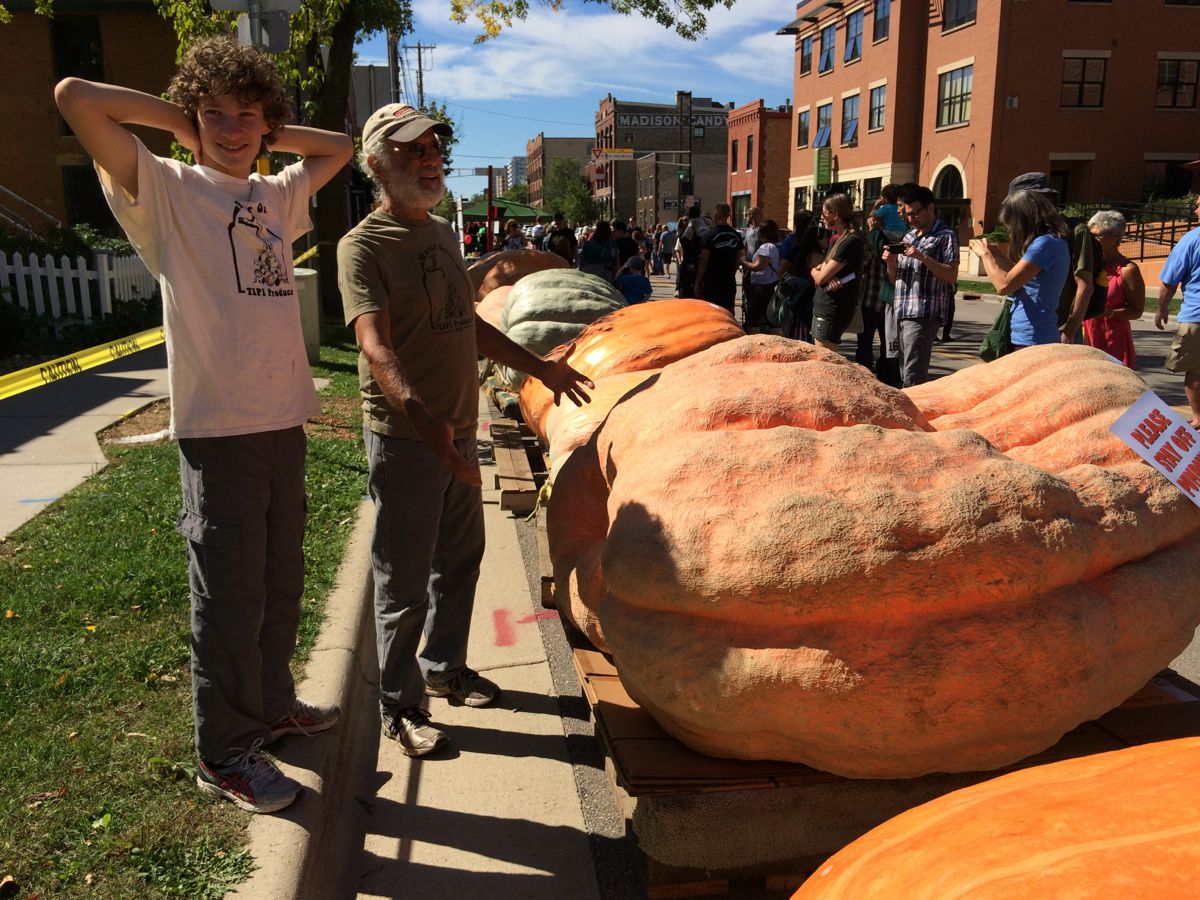
We feel like such amateurs. Maybe for next year’s CSA boxes?
Extra produce sales
Hey folks, I’d like to explain our extra produce sales, for the benefit of new members this year. You’ve probably noticed our emails offering extra tomatoes or peppers for sale. We offer these sales at peak season when we have more than enough for the CSA boxes. It’s a chance to preserve some tasty produce for winter. At this point, tomato sales are done for this season. We might offer red peppers again, but maybe not. Later this fall, we’ll offer boxes of green kale. Basil is unlikely this year due to a disease problem.
The turn-around time to place an order is often short, sometimes just a few hours. We realize this can be difficult for members, but we cannot open sales until we’re confident we have what’s needed for the CSA boxes. That often means a short window to place your order. FYI, I usually make the announcements on Tuesday or Wednesday.
Veggie List and Veggie Notes
Red potatoes, 3.5 lb
Italian beans, 1.75 lb
Broccoli, 1 – 3 heads depending on size
Leeks, about 1.5 lb
Slicing tomatoes, about 2 lb
Red bell peppers, 2
Zavory “not-hot” habanero chiles, small handful
Cilantro, 1 bunch
Garlic
A few sites will get one heirloom tomato per box.
Next week’s box will probably contain carrots, beets, winter squash, edamame soybeans, peppers, onions and more.
Red potatoes – Finally, we have potatoes for you. There has not been room in the CSA boxes until now! Chad Malek of Specialty Potatoes and Produce in Rosholt grew these organic potatoes for us.
Italian beans – This is Steve’s favorite type of bean. Broad and sturdy, they can be lightly cooked or braised for a longer time. New York Times writer Melissa Clark’s article “Beans in Their Own Sweet Time” is a revelation about how to braise beans. She writes “The beans I grew up on were barely blanched until green as grass, retaining a fresh, chlorophyll taste and a firm al dente texture that seemed to make sense with their spaghetti-thin girth…. But when the Italian mother of my college roommate offered a plate of tender beans, I found them addictive from the first melting bite. With a droopy texture I would have considered overcooked as a know-it-all kid, these gorgeous legumes were a revelation. Gently simmered in a rich garlic-flecked tomato sauce until soft and velvety but not the least bit mushy, I had seconds, then thirds, which tickled the cook to no end.” Basically, instead of a quick steaming, you braise the beans in a flavorful sauce until they are very tender and have taken up the sauce’s flavors. Melissa’s recipe calls for green beans, but I like braising Italian beans best.
Leeks (look like big scallions) – These alliums have a milder flavor than onions. Nonetheless, they can be used in recipes that call for onions. To wash, split the leek lengthwise, from the green tops about halfway to the base, leaving the base intact. Rinse well under running water, separating the layers to flush. If necessary, split the leek further if soil has penetrated more than halfway down the leek. Shake dry. Leeks are generally eaten cooked. They can be sauteed, steamed or roasted. Intact leeks will store 2 to 3 weeks if covered loosely and refrigerated. The outer leaves will yellow. Just peel them off and discard. The inner leek layers will be fine.
Slicing tomatoes (mixed colors) – We’re happy to still have tomatoes but recognize these will not store long. It’s best to refrigerate them. Better yet, eat them quickly!
‘Zavory’ habaneros (small, orange or red) – These habaneros are NOT HOT. Almost all the spice has been bred out of them, leaving mild heat in the seeds. Now we can all learn what habaneros actually taste like. The blazing heat always got in the way, as normal habaneros are about 200,000 Scoville units. Lo-and-behold, these Zavory chiles have great, fruity flavor, really interesting. You should still approach them with caution. We’ve found rare off-types mixed in, but very infrequently, and not with the full heat of a normal habanero. As always, remove the seeds if you want to reduce the risk of spiciness.
THIS WEEK’S RECIPES
Comforting Classics
Roasted Romano Beans
Bean and Tomato Sauté
Roasted Tomato Thyme Vinaigrette
Beef, Leek and Potato All Day Stew
Broccoli Cashew Stir Fry
Balsamic Roasted Potato
Outside the Box Recipes
Indian Spiced Romano Beans
Leek and Bean Barlotto
Yucatan Tomato Habañero Salsa
Saffron Rice with Frizzled Leeks
Smashed Potatoes with Broccoli
Lemon Dijon Dill Potato and Broccoli Salad
Kitchen Sink Recipe
Quick and Easy Meal Recipe
Farm news from Steve
- On: September 16, 2015
 0
0
Even with this week’s summer-like temperatures, autumn is creeping into our farm lives.
We’re dismantling fields that we so carefully constructed and tended during the past few months. Acres of worn-out zucchini, cucumber, melon plants are mowed. Thousands of linear feet of plastic mulch are undercut with a simple implement, then pulled up and out of the fields by our crew – a dusty job! The drip irrigation lines that kept these crops growing so well through our dry summer are mechanically wound into compact balls, ready to be recycled. The used plastic mulch is too dirty for recycling, and is destined for our landfill in Janesville.
After these fields are cleared off, a single pass with our strongest tractor and a heavy disc levels the ground, mixing in crop and weed residues, adequate preparation for us to seed a cover crop.
Each week now we’re planting several acres of winter rye (the rye in your rye bread) mixed with hairy vetch. This mixture makes 6-8 inches of growth this fall, enough to cover the ground, minimizing erosion and moderating soil temperatures through the winter. At the first hint of spring, the rye will green up and resume growing, capturing a large amount of carbon from the air. The vetch restarts a bit later, and, as a legume, fixes atmospheric nitrogen into a form that soil microbes, and then our crop plants, can use for growth.
These cover crops, planted this week, are a foundation for our farm’s success next year. We keep the cycle going. Steve
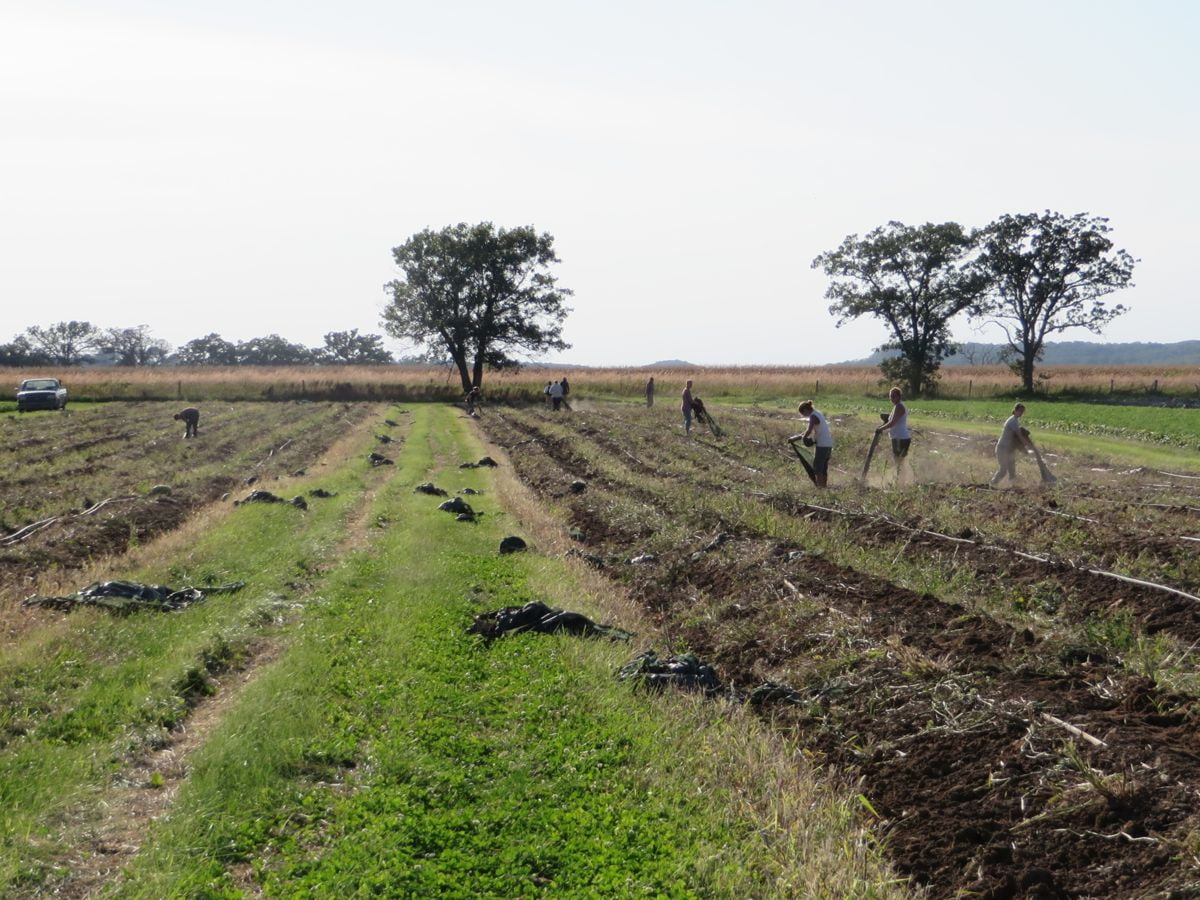
Pulling up plastic mulch on a beautiful fall day.
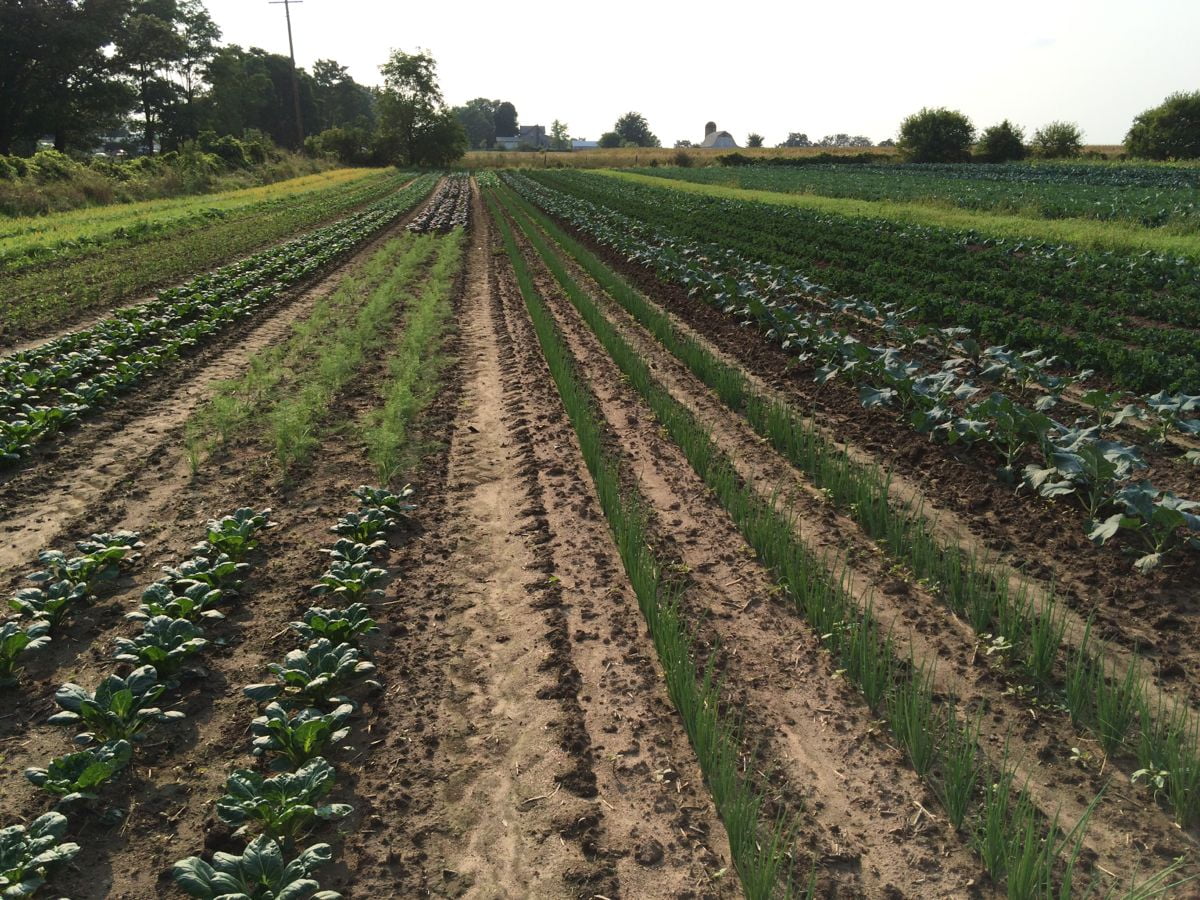
The fall crops are growing well. There’s lots yet to harvest.
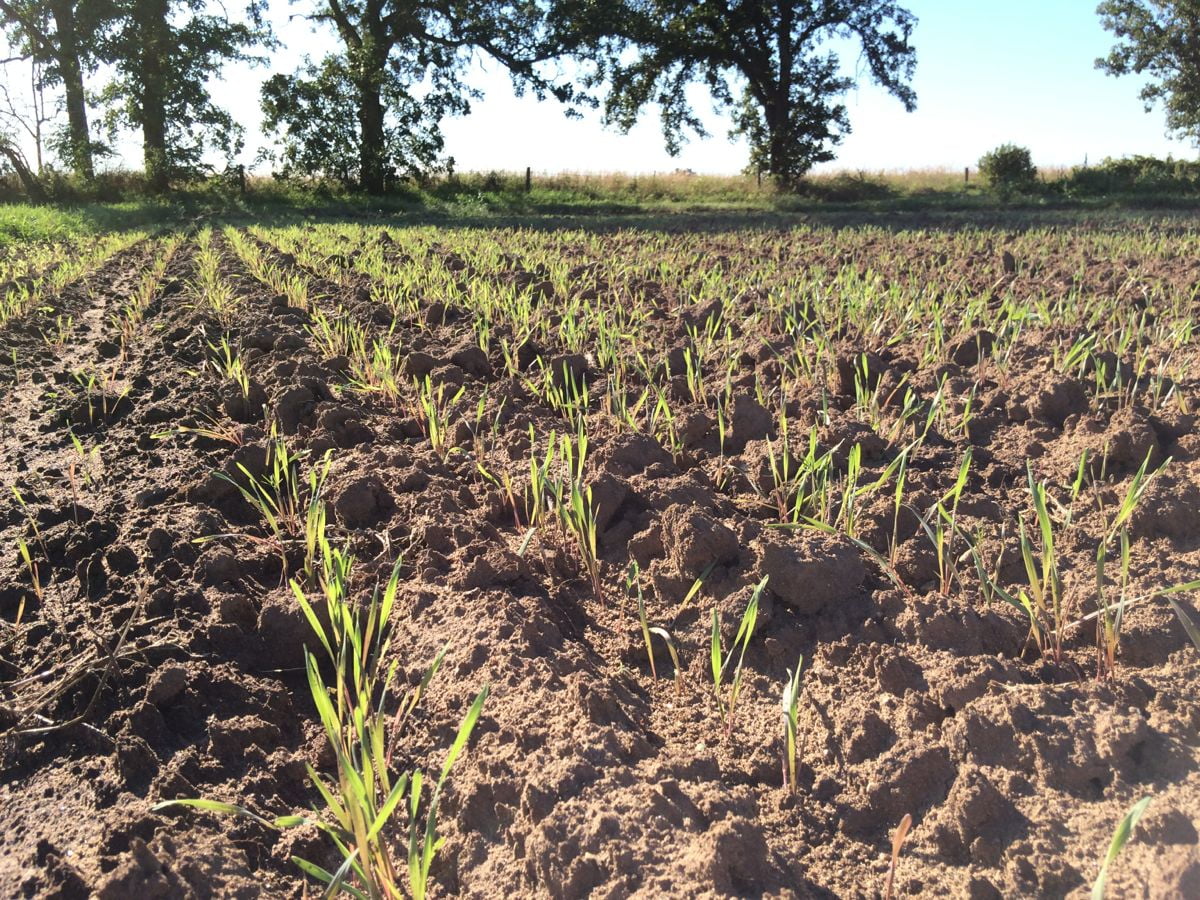
Cover crops are up! The rye seedlings look fragile but will form a dense mat before winter arrives.
Veggie List and Veggie Notes (Sept. 17/18, 2015, week #18, green EOW)
Updated 9/17/15
Here is our best guess of what will be in the box. Do not be surprised if your box does not contain everything on the list. There are many large vegetables this week, and we will fit as many as we can in each box.
Green cabbage, 1
Lacinato kale, 1 bunch
Slicing tomatoes, 4 lb
Colored bell pepper, 1
Orano peppers, about 2
Poblano chiles, 2
Yellow onions, about 2
Thai basil, 1 bunch
Garlic
Broccoli, 1 large or 2 small heads
Sweet dumpling OR delicata squash, 1 or 2
Everyone will receive two+ items from this list:
Celery OR eggplant OR extra broccoli OR an heirloom tomato
Next week’s box will probably contain potatoes, broccoli, Italian beans, leeks, tomatoes, peppers of some sort, garlic and more.
Slicing tomatoes – Keep a close watch on your tomatoes this week. They look and taste good but might not store for long. It’s that time of year. Eat them promptly, or refrigerate once ripe.
Celery – Our celery is strongly flavored and more fibrous than typical grocery store celery. Check the middle of the head – it may need trimming. We continue to tinker with our one annual celery planting, attempting to find the right fall harvest window. We planted it late enough to mature in fall, and be more tender than celery harvested during the summer. It sort of worked. This celery is more tender than in other years. However, planting later created more opportunity for insect attack. Look it over, taste it raw, and decide how you want to use it.
Poblano chiles (dark green, shiny, triangular) – These chiles have low-to-medium heat and great flavor. Most I’ve cooked so far this year are milder than usual, but a few were corkers.
Sweet Dumpling winter squash (round, speckled green and white or yellow) – This is one of our most flavorful winter squashes and a personal favorite. Sweet Dumpling are one of the first winter squash types ready to eat in fall. These will not store for long so eat them soon.
Storage: Store all winter squash at room temperature.
Preparation: These squash have a central cavity that can be stuffed if you wish. Cut squash in half, scoop out and discard the seeds. To cook, I place the cut squash face-down on a cookie sheet, then put some water in the pan, and roast at 400 oF until easily pierced with a fork. The water in the pan is optional. The flavor is best if you allow the pan to dry during the cooking, so the squash has a chance to caramelize.
Thai basil – This is the same Thai variety we sent a few weeks ago, chosen for how well it holds up to a late summer disease. We like this basil! The flavor is excellent. There’s a mild hint of anise, without bitterness. This is a strong basil so try using half the amount you would add when using Italian basil. Taste and add more if you wish.
THIS WEEK’S RECIPES
Comforting Classics
Chicken and Andouille Gumbo or Red Bean Gumbo
Marcella Hazan’s Tomato Sauce with Butter and Onion
Sage Rubbed Roasted Sweet Dumpling Squash with Onions and Craisins
Fish Taco with Shredded Poblano and Cabbage in Chipotle Crema
Wilted Kale with Bacon and Vinegar (Vegetarians and non-bacon eaters — click through for award winning variation with no bacon!)
Yogurt Eggplant Spread
Outside the Box Recipes
Bloody Mary Salad
Baked Eggplant, Peppers and Tomatoes with Almonds
Curried Chickpea and Quinoa Stuffed Squash
Indian Coleslaw
Grilled Lacinato Kale
Burnt Eggplant and Israeli Couscous Soup
Kitchen Sink Recipe
Quick and Easy Meal Idea

